Rich, muted, and quietly sophisticated, dark olive green has emerged as one of 2025’s most requested exterior hues. When that deep, botanical shade wraps a house and punctuates every corner with crisp black trim, the result feels both modern and timeless—the architectural equivalent of a tailored suit cut from organic cloth. Designers praise the palette for blending effortlessly with surrounding foliage while still standing out against bright skies or snowy backdrops. Homeowners appreciate its surprising practicality: the color hides dust, pairs with numerous roof materials, and frames windows with gallery-like drama. Step outside and explore twenty distinctive ways this compelling scheme elevates everyday curb appeal.
1. Timeless Curb Appeal: Dark Olive Green House with Jet-Black Accents
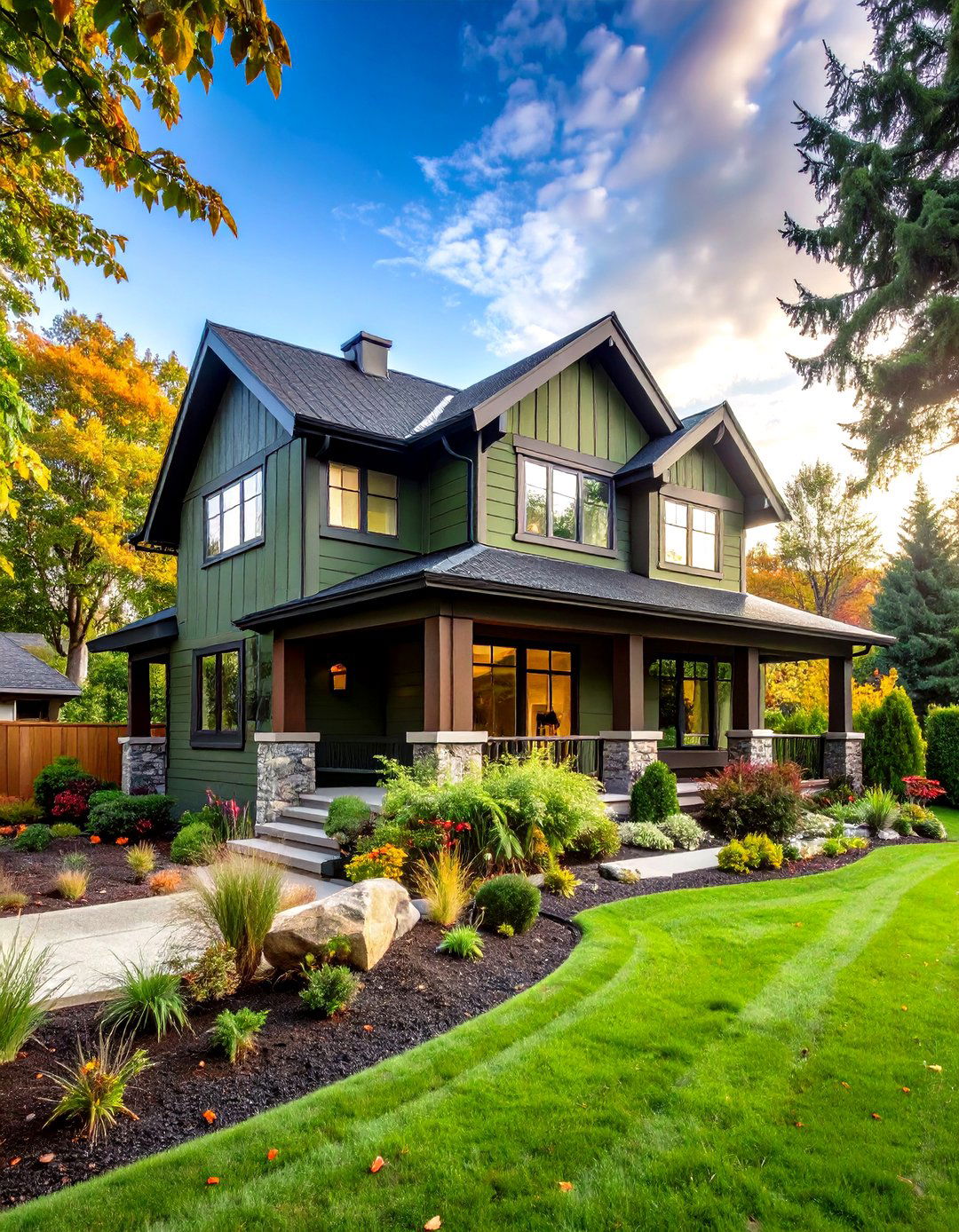
An instant classic unfolds when a dark olive green house receives disciplined strokes of jet-black trim. The rich siding grounds the structure, allowing rooflines, fascia, and window grids to read like inked illustrations against a living canvas. This high-contrast balance appeals to renovators who favor understated sophistication over louder palettes, yet it remains easy to personalize with natural stone, bronze hardware, or copper gutters. Professionals note that low-sheen black paint amplifies the depth of olive pigment while masking minor surface imperfections. Because both colors resist fading, the look stays relevant across decades and climates, enhancing resale potential and homeowner pride.
2. Warm-Neutral Trend: Dark Olive Green House Embracing 2025 Color Forecasts
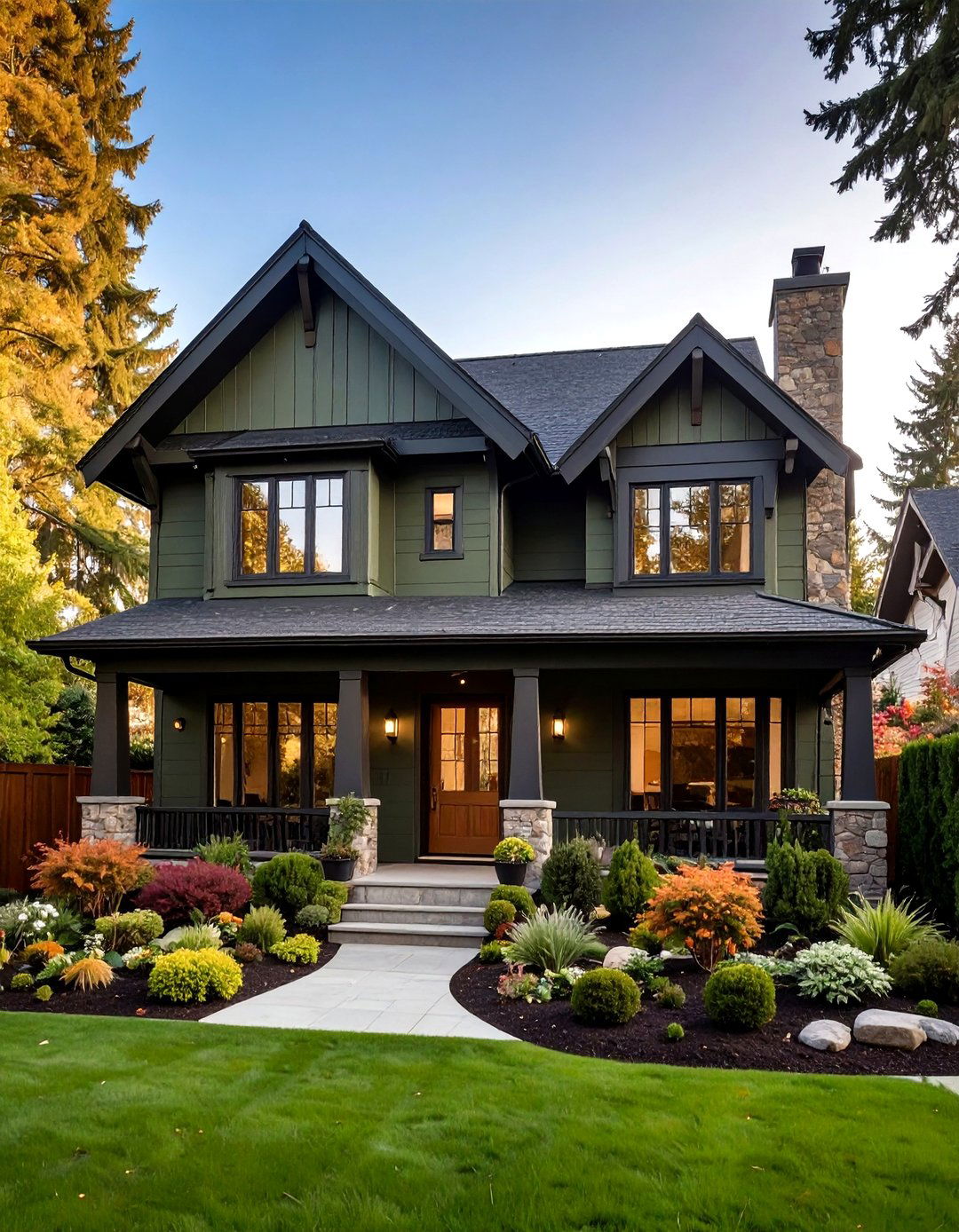
Owing to 2025’s shift toward warm neutrals, painting a house dark olive green with black trim feels especially of-the-moment yet naturally enduring. Color analysts rank olive alongside cinnamon and terracotta as shades that echo the landscape, meaning your façade blends effortlessly with native plantings while still reading intentional and curated. Black framing intensifies that nature-first narrative by giving windows the crisp outline of botanical sketches. The combination also masks dust, an advantage in windy regions. If you plan to sell within five years, aligning with current forecasts reassures future buyers they will not need an immediate repaint, saving time and expense.
3. Scandinavian Simplicity: Dark Olive Green House with Black-Framed Glass
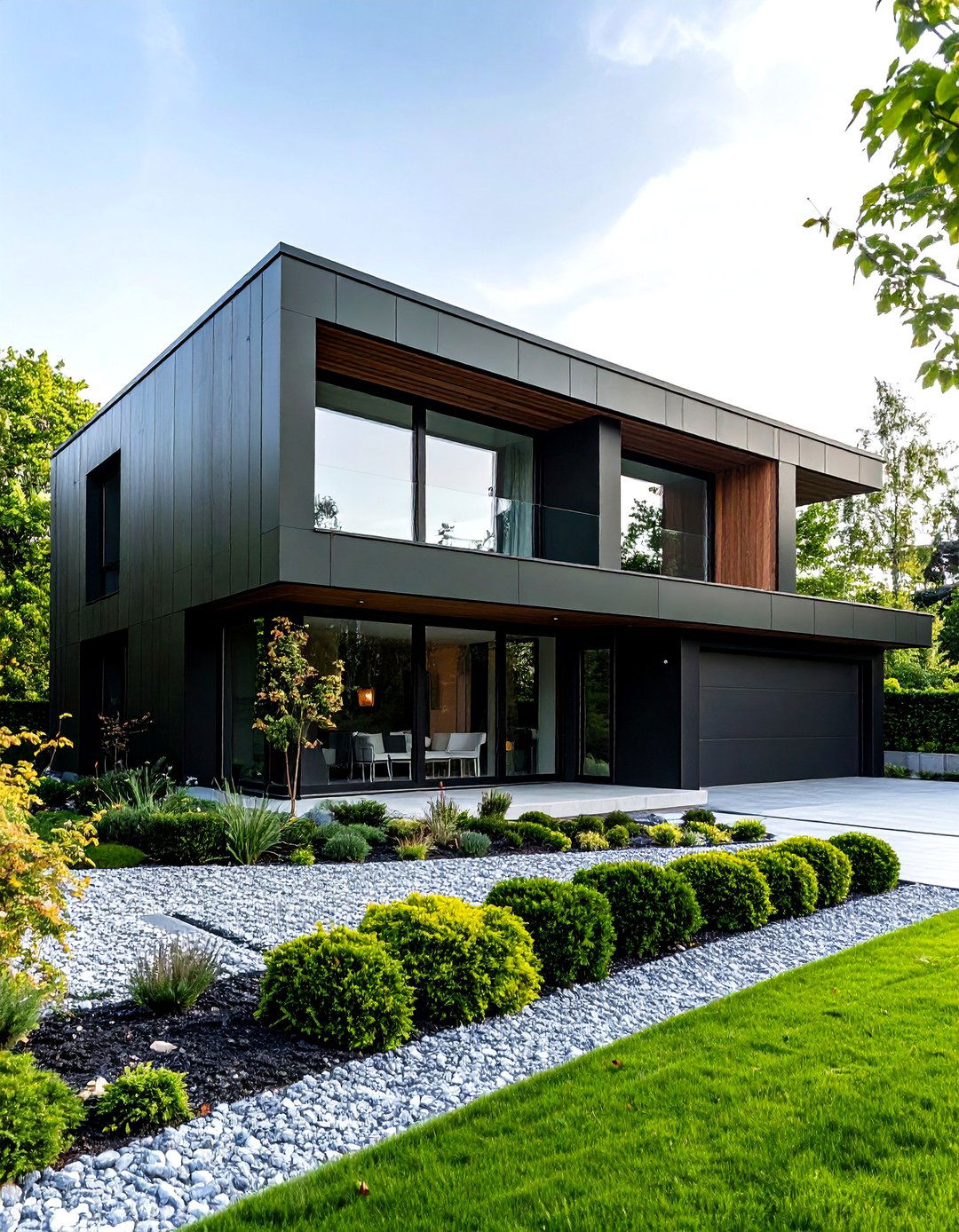
As Scandinavian minimalism migrates to North American neighborhoods, many architects specify dark olive green cladding and black-framed glass to channel hygge without excessive ornamentation. Narrow-profile aluminum windows make wall planes look lighter, a trick that offsets the depth of olive siding so the house never feels heavy. Maintain the purity of the concept by paring back landscaping to gravel paths, grasses, and pared-down evergreen shrubs. Because the palette relies on texture rather than color contrast, invest in flush garage doors and concealed gutters to keep visual lines uninterrupted. The resulting elevation looks like a contemporary cabin—simple, grounded, and irresistibly welcoming.
4. Board-and-Batten Texture on a Dark Olive Green House
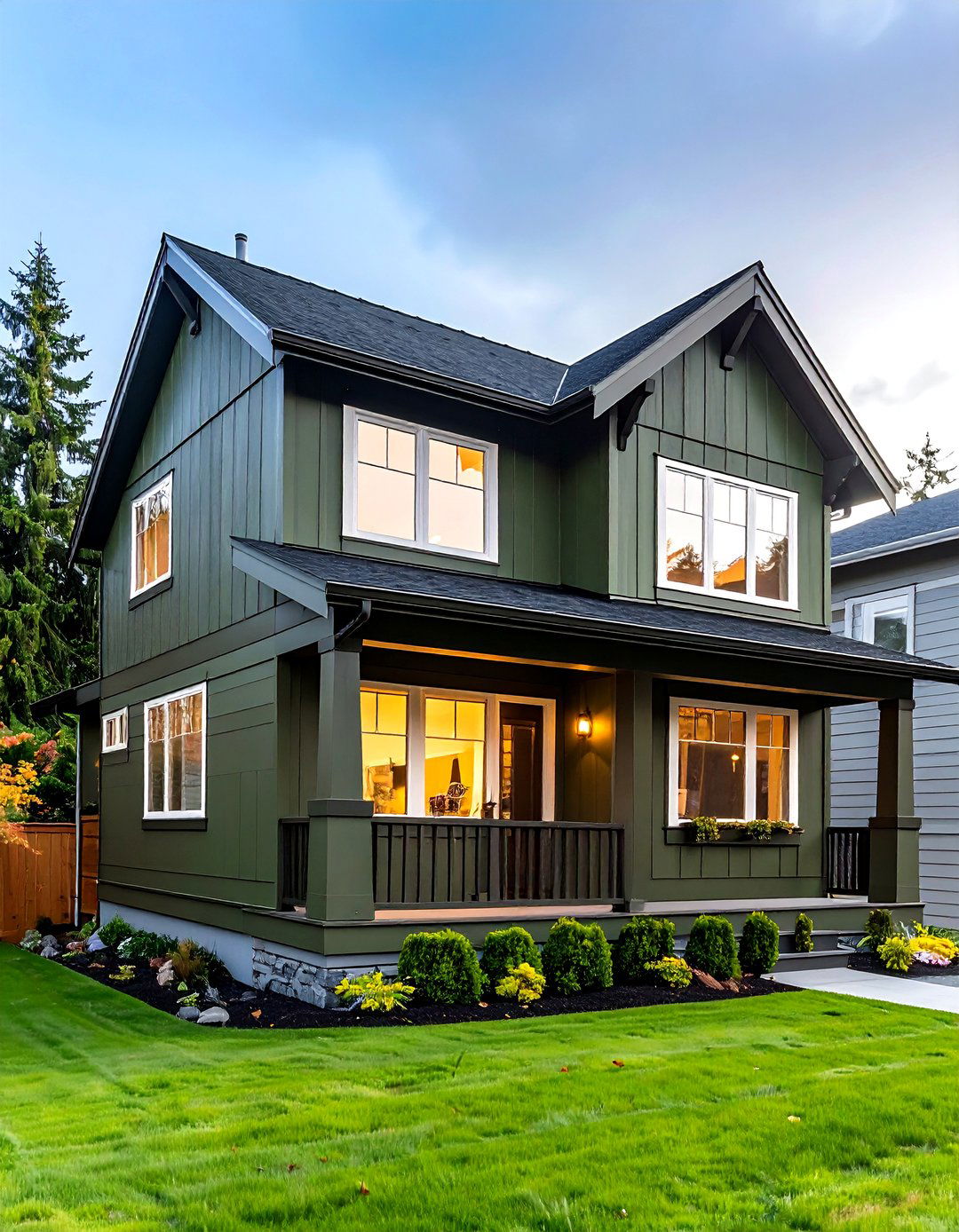
Board-and-batten siding lends vertical rhythm to a dark olive green house, preventing broad walls from appearing flat or monolithic. The alternating wide boards and slender battens catch shadow, giving life to the muted hue throughout the day. Painting battens in the same olive tone ensures subtle sophistication, while outlining windows and eaves in black keeps the scheme readable from the street. This cladding solution is particularly budget-friendly when using pre-primed fiber-cement panels that accept darker pigments without warping. To emphasize the lines further, install up-lighting at ground level; each beam of light grazes the texture, adding nighttime drama without additional ornament.
5. Black Standing-Seam Roof Crowning a Dark Olive Green House
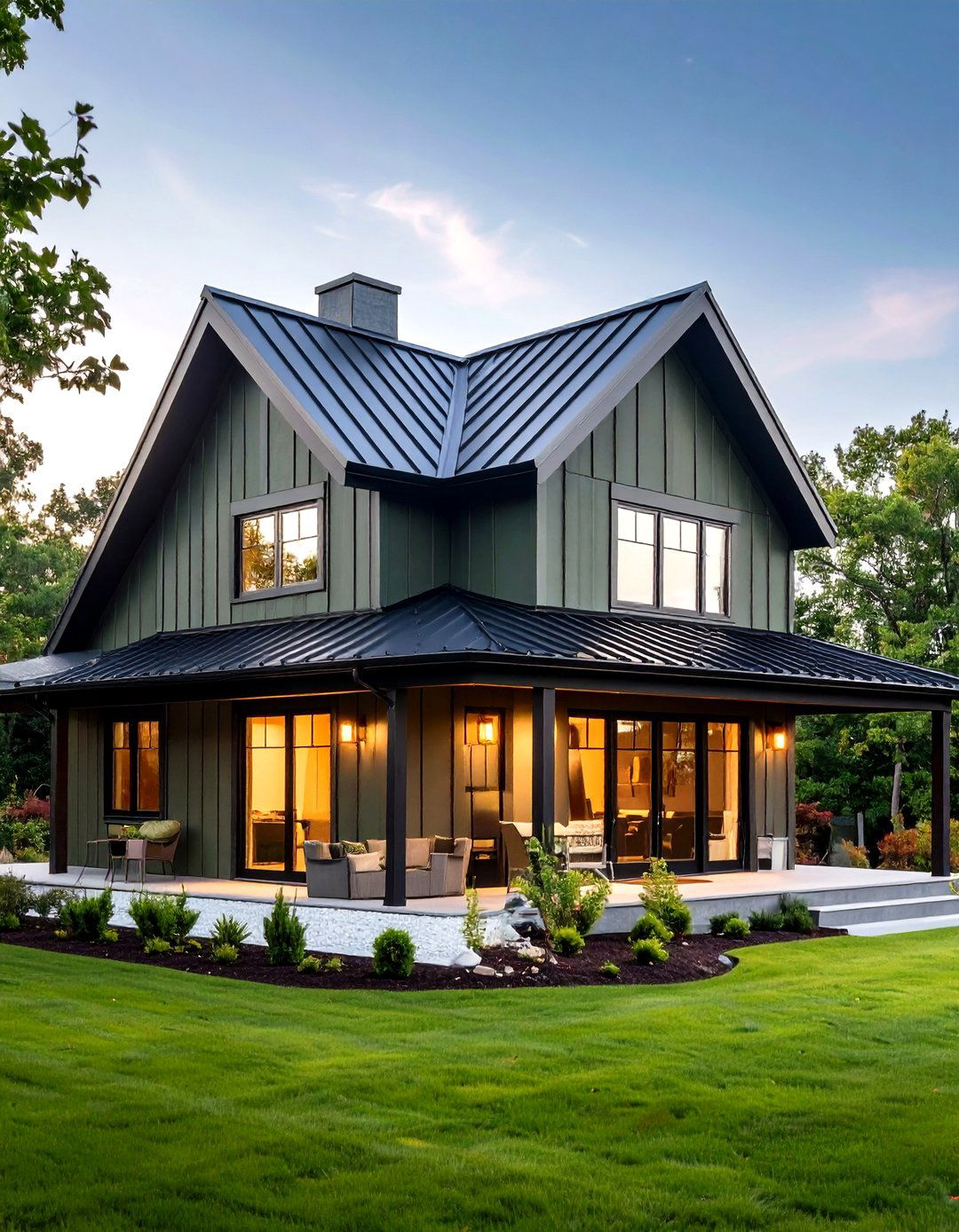
Looking upward, a matte black standing-seam metal roof crowns a dark olive green house like a tailored hat, sharpening silhouettes and boosting energy efficiency. Metal reflects radiant heat while its low profile prevents wind uplift, making it an eco-wise companion to the earthy siding. Because the roof color matches window and trim paint, all horizontal and vertical lines feel deliberately unified. Consider extending the overhang an extra foot; the darker palette under shadow reduces solar gain on south-facing façades and provides a comfortable porch refuge below. With minimal maintenance and a 40-year life span, the roof ensures the design endures.
6. Low-VOC and Recycled Paint Choices for a Dark Olive Green House
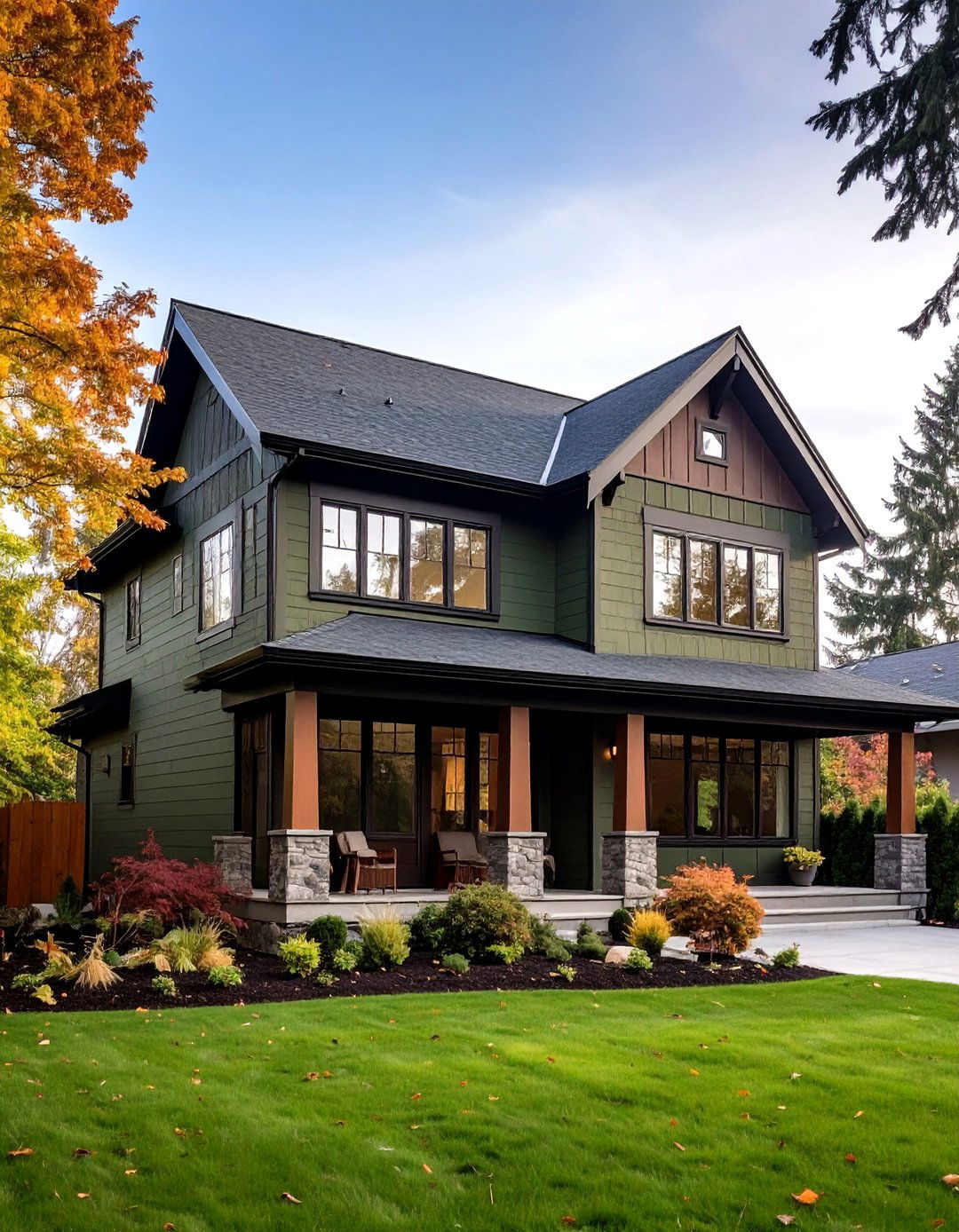
By selecting low-VOC, recycled-content paint in dark olive green, homeowners lower off-gassing during application and keep the color’s earthy credentials genuine. Many premium manufacturers offer formulations that include reclaimed pigments yet still achieve deep saturation, so you need fewer coats to hide primed siding. Pairing this sustainable finish with black trim made from 60 percent recycled aluminum or composite boards completes a cradle-to-cradle exterior story. Because darker colors absorb more heat, confirm your insulation meets regional energy codes; the investment pays back quickly through reduced heating bills in winter months. The result is a conscientious exterior that looks sophisticated and feels responsible.
7. Warm Wood Porch Offsetting a Dark Olive Green House
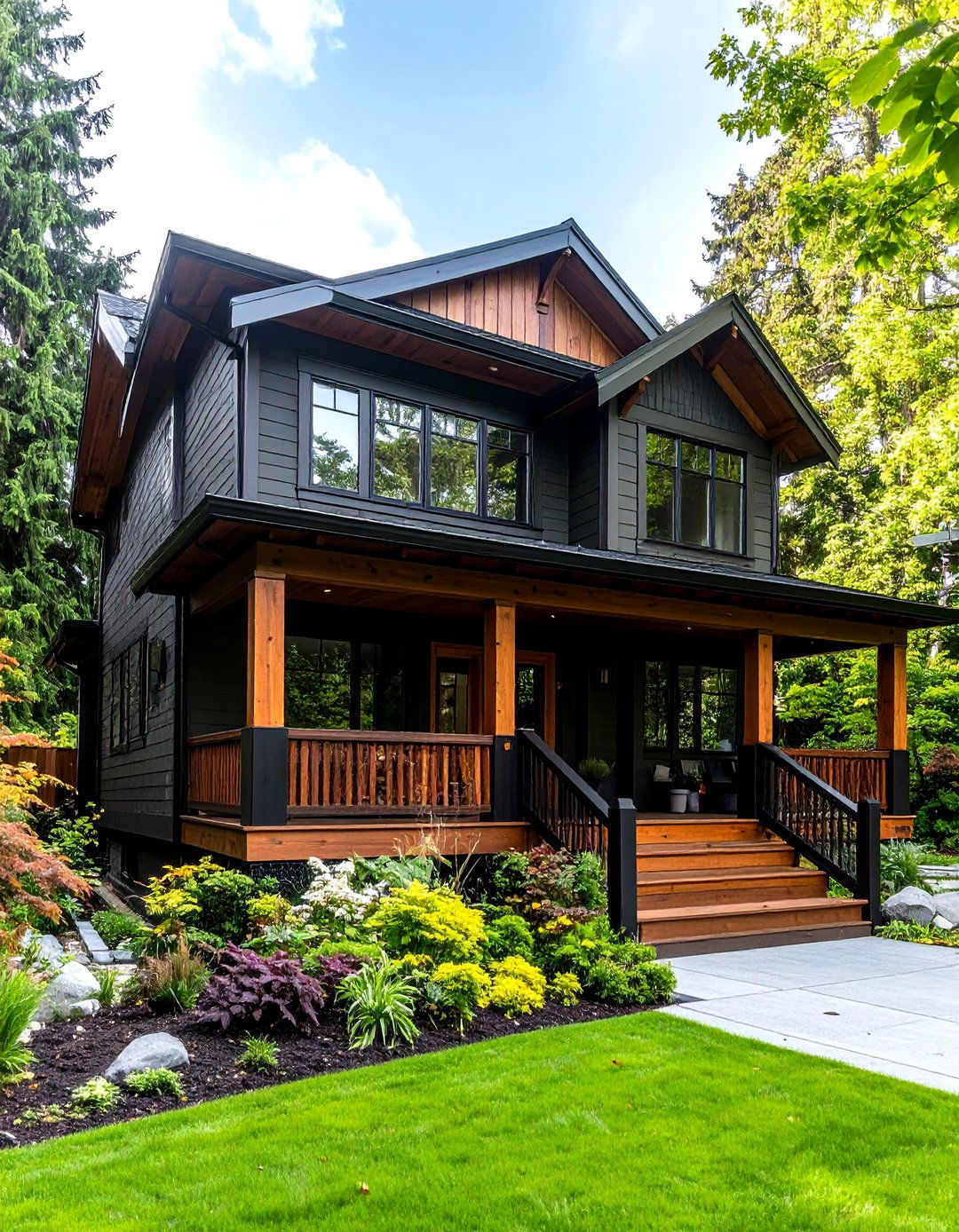
Take balance further by framing the entry of your dark olive green house with a warm cedar porch. The golden-brown tones temper the cooler undertones of olive, producing a magnetic contrast with the neighboring black railings. Opt for a semi-transparent stain rather than paint, allowing grain to show and reinforcing the home’s biophilic story. If possible, extend the decking material upward to create wood-wrapped columns, giving vertical continuity from ground to roof. Finish with matte black cable railings for safety without visual heaviness. This trio—olive, black, and natural wood—creates a front elevation that feels both contemporary and inviting to guests.
8. Coastal Twist on a Dark Olive Green House Palette
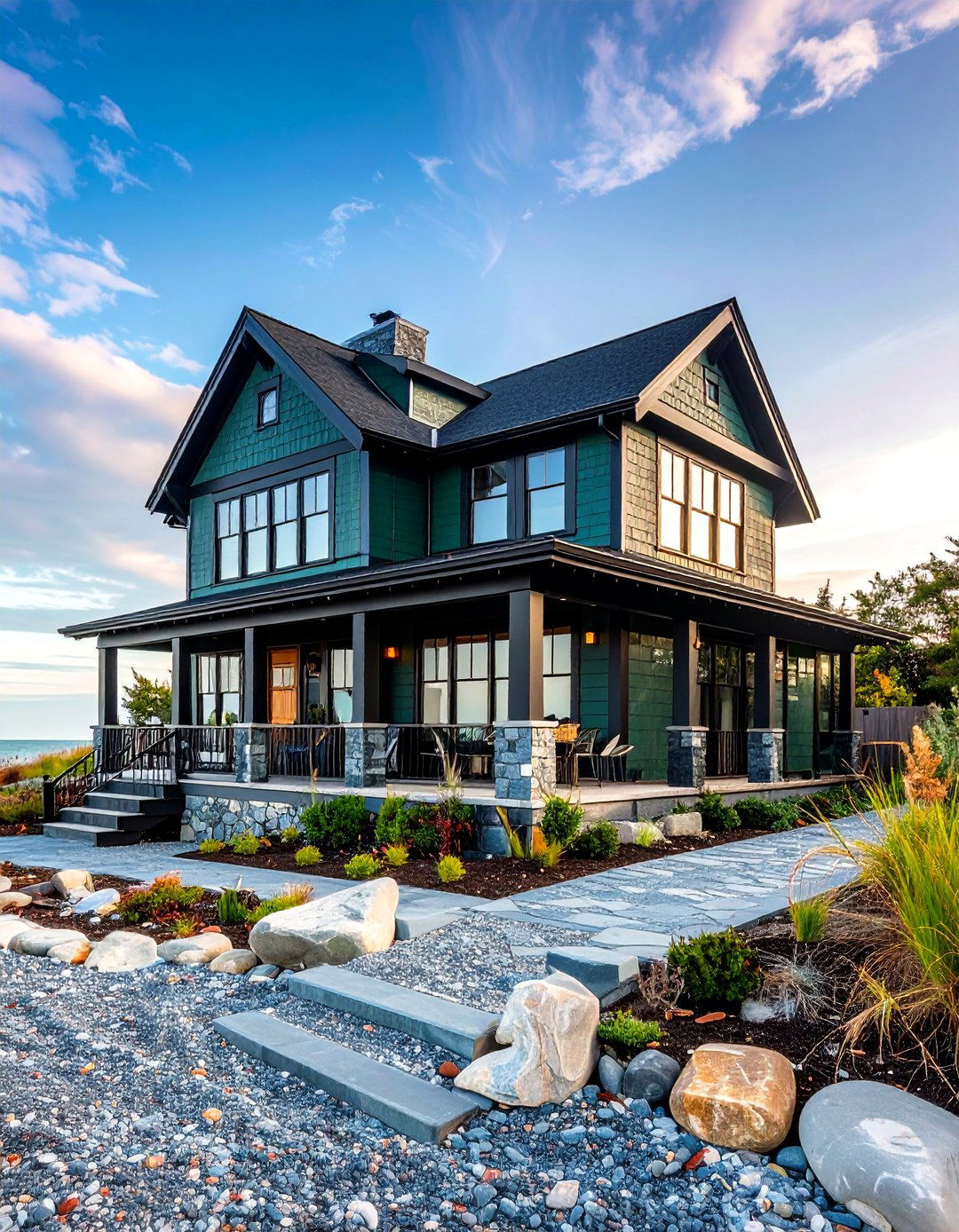
Although olive is often linked to forests, it can read surprisingly coastal when paired with black trim and brushed-nickel accents. Swap out busy shutters for streamlined louvers, then introduce sea-salt-gray pavers to lighten the foundation line. In hurricane-prone zones, choose fiber-cement clapboards rated for high-wind impact; the dark pigment camouflages any minor storm staining between cleanings. Stainless steel house numbers pop brilliantly against the green and tie back to marine hardware on railings. To finish the seaside narrative, plant silverleaf natives like Artemisia or lavender along the façade; their muted foliage bridges the color story between siding and sky.
9. Stone Skirting Elevating a Dark Olive Green House
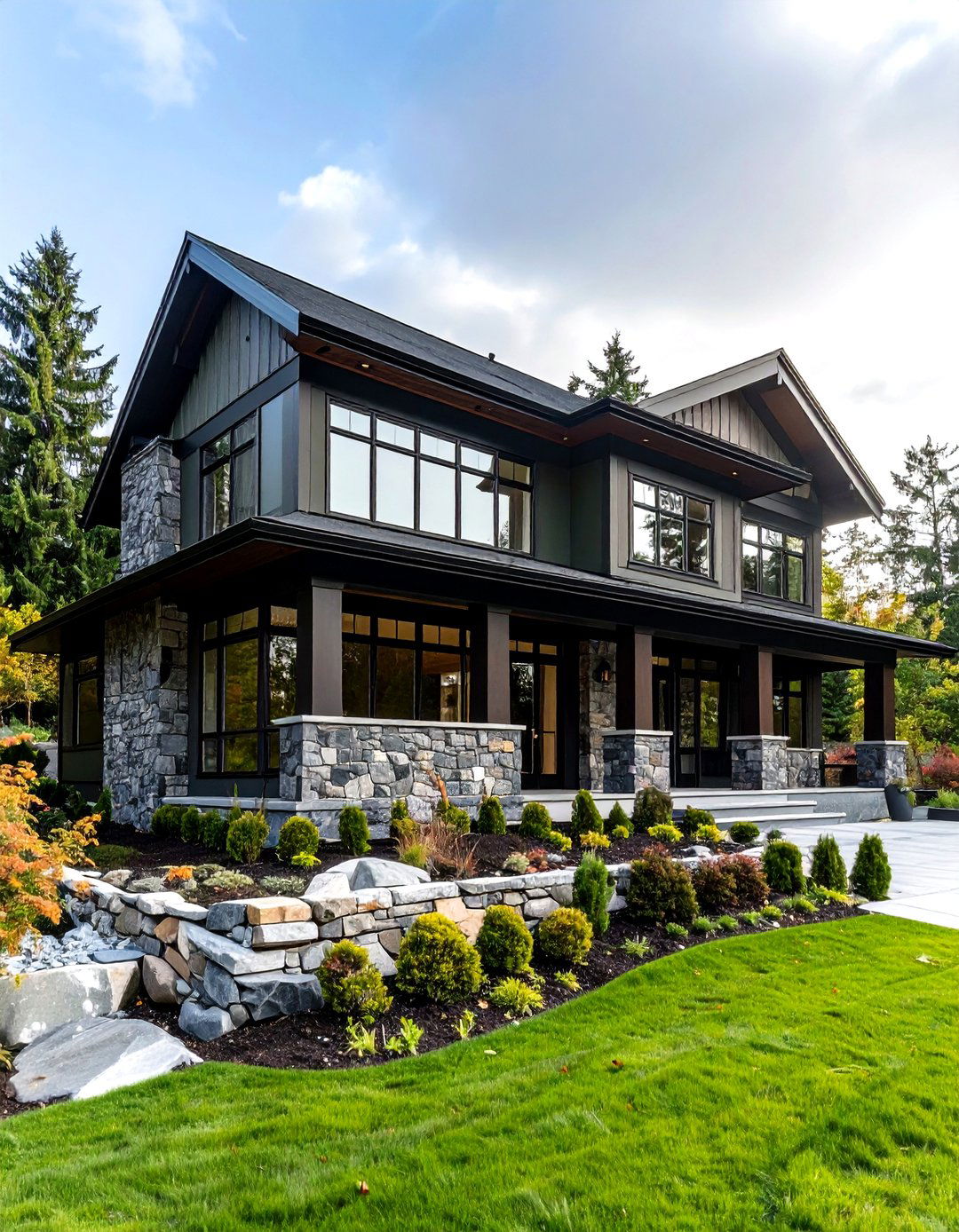
Bringing a chunkier material like ledger-stone to the lower three feet of your dark olive green house establishes visual weight and shields siding from splash damage. Neutral quartzite or weathered granite offers subtle warmth that harmonizes with the green while letting the black trim act as a crisp divider above. Extend the stone along porch steps to create a continuous base, then up-light selected joints to reveal texture at twilight. Beyond aesthetics, stone delivers thermal mass, helping to regulate indoor temperatures. This layered approach feels rooted and timeless, especially when landscaping repeats the stone’s flecks through gravel or river rock.
10. Slim Black Window Grids on a Dark Olive Green House
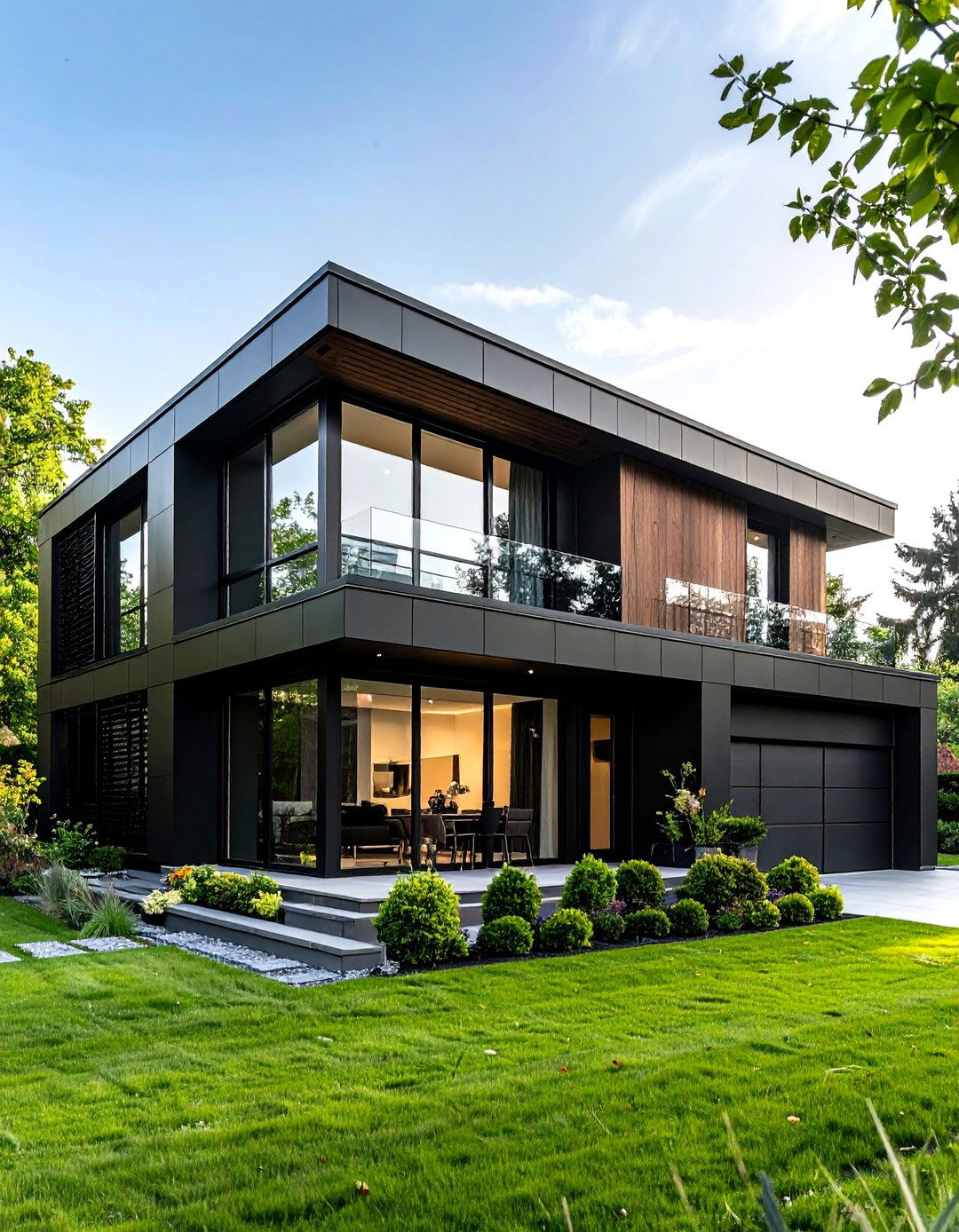
For window upgrades, consider ultra-slim black grids that punctuate a dark olive green house like modern latticework. The trick is to keep mullion bars under seven-eighths of an inch so the black lines highlight geometry without overwhelming glass. Metal-clad wood frames offer the warmth of timber inside but stay maintenance-free outdoors. Choose low-E glazing with a slightly warm tint; the subtle caramel glow complements olive hues and reduces glare. When arranged symmetrically, the grid pattern reinforces architectural rhythm and draws the eye upward, giving even single-story homes a stately bearing. Complete the composition with black exterior shutters secured by matte iron holdbacks.
11. Shade-Loving Landscaping for a Dark Olive Green House
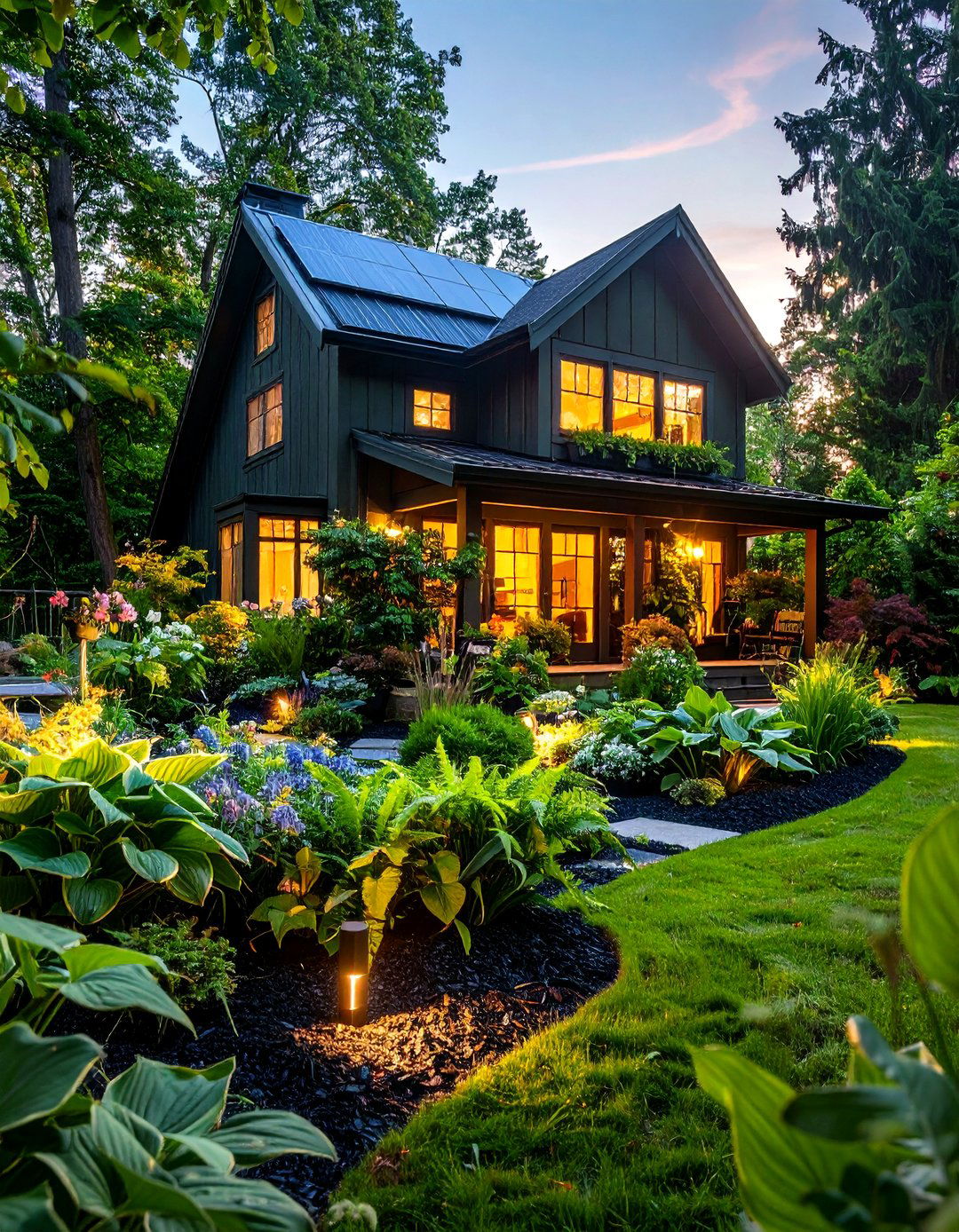
With shade-tolerant plantings like hostas, Japanese forest grass, and ferns, underscore the lush character of a dark olive green house while requiring minimal maintenance. Their chartreuse and lime notes create gentle contrast against the siding, ensuring the palette never feels monotonous. Line pathways with black-dyed mulch or basalt gravel; the dark ground layer visually expands garden beds and connects back to trim color. Strategically placed solar uplights highlight foliage architecture, casting delicate shadows onto the façade after sunset. This landscape strategy not only reinforces aesthetic cohesion but also boosts biodiversity, inviting pollinators into an environment that feels curated yet natural.
12. Heritage Bungalow Revival in Dark Olive Green House Colors
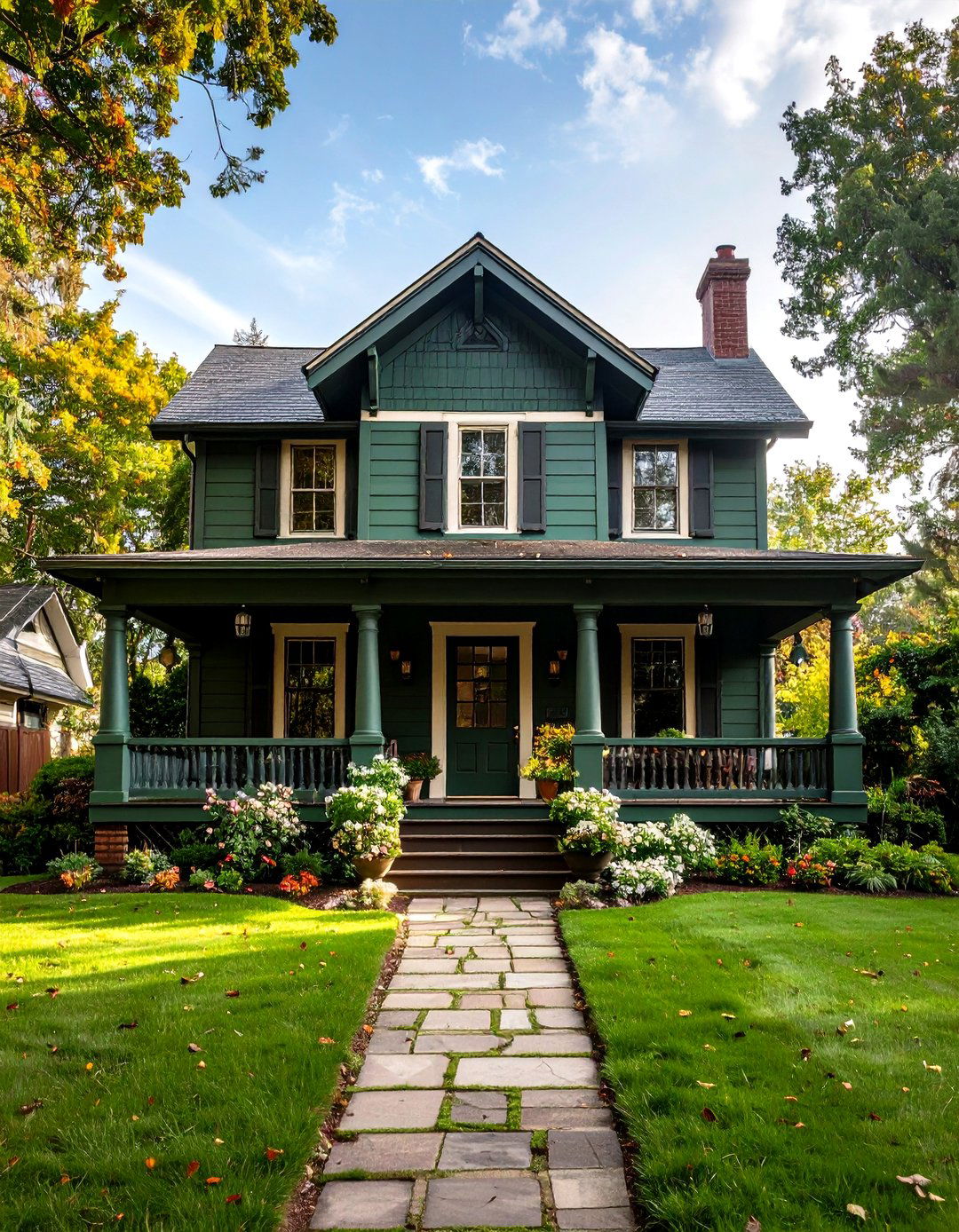
One cannot overlook the charm of coating a 1920s bungalow in dark olive green while restoring its dentil molding and corbel brackets in deep black. The historically sympathetic green honors Craftsman roots, whereas the darker trim sharpens lined details lost under previous lighter paints. Replace tired porch columns with square, tapered versions and fit period-appropriate lanterns in oil-rubbed bronze for authenticity. Because older wood can absorb paint unevenly, prime with high-build acrylic, then apply two thin finish coats for longevity. This respectful revival brings the bungalow back to life without straying into novelty, satisfying preservation boards and modern tastes alike.
13. Matte Black Hardware Detailing a Dark Olive Green House
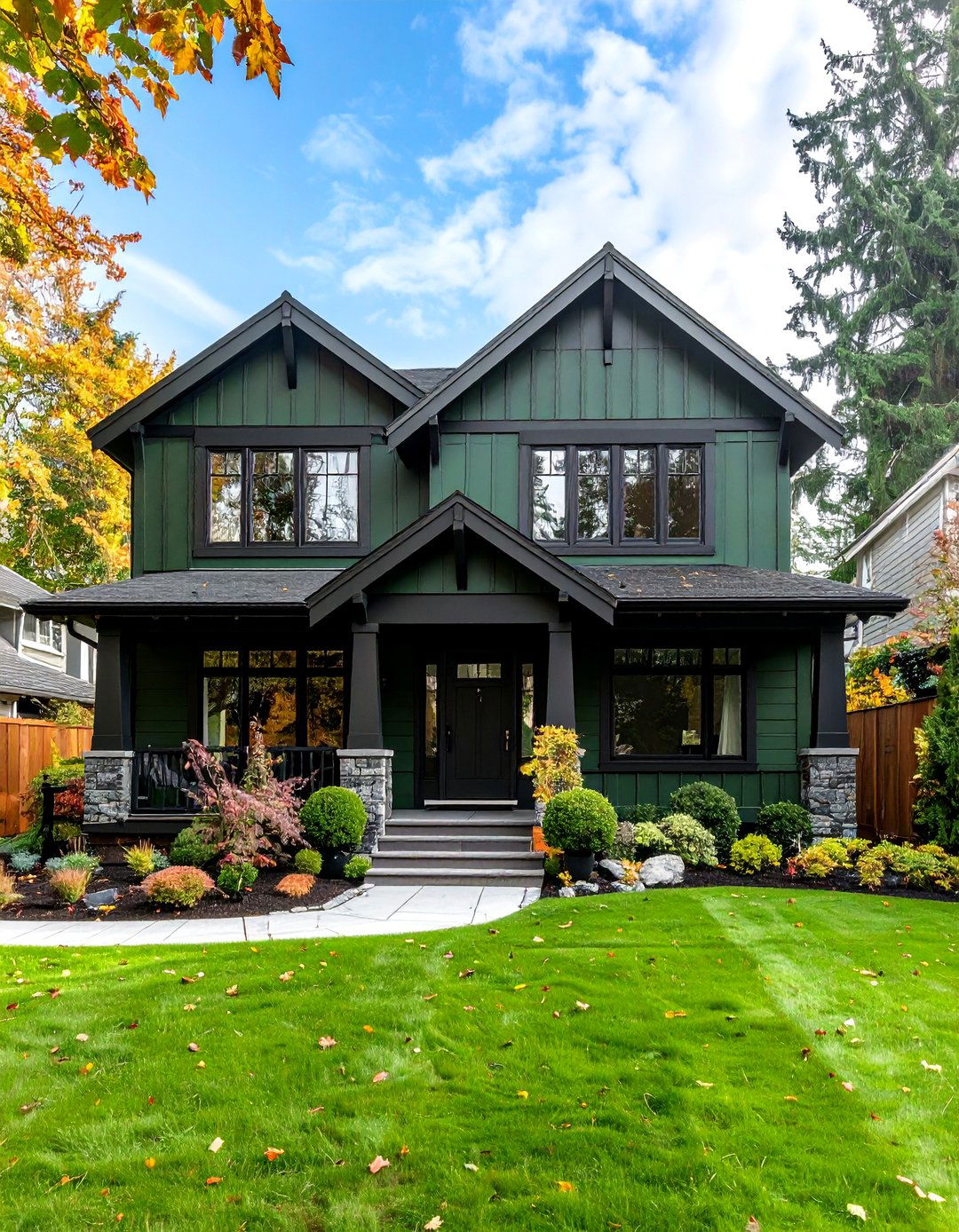
Moreover, swapping shiny fixtures for powder-coated matte black hardware refines every touchpoint on a dark olive green house. From mailbox to door hinges, consistency creates a tailored aesthetic reminiscent of custom millwork. Seek marine-grade stainless or aluminum bases before coating; this prevents rust rings on the green siding. Oversized house numerals, at least six inches tall, ensure legibility and act as sculptural accents. On French doors, twin vertical pull bars introduce a subtle industrial vibe that feels fresh against the muted olive backdrop. Even utility doors can disappear when handles, vents, and louvers share the same subdued black finish.
14. Passive-Solar Thinking for a Dark Olive Green House
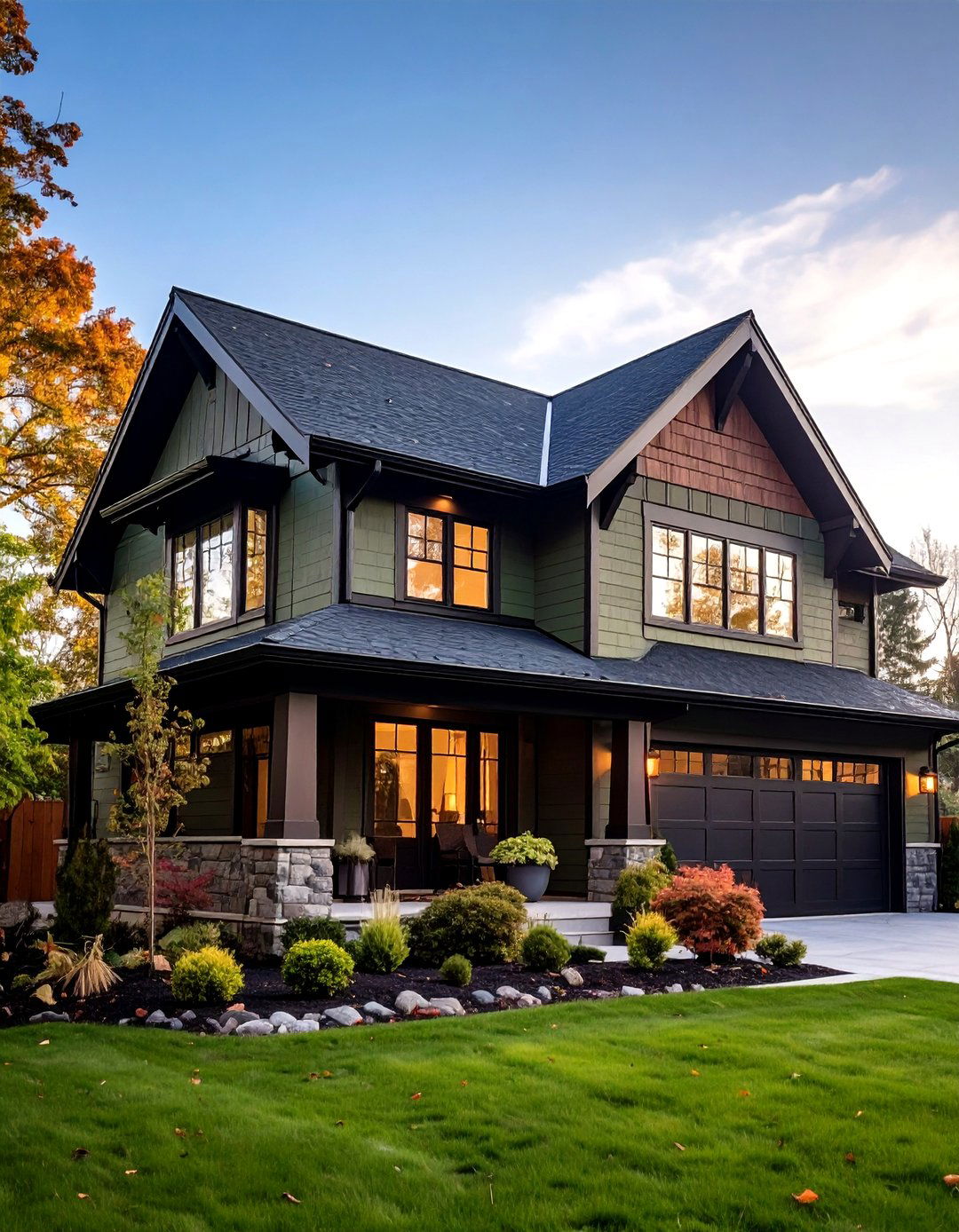
As climate consciousness grows, passive-solar strategies integrate seamlessly into a dark olive green house with black trim. Deep roof overhangs above south-facing windows let winter sun penetrate while shading summer glare, balancing the heat absorption properties of dark siding. Paint the interior side of trim white to reflect daylight deeper indoors, reducing artificial lighting needs. Consider adding a thermal break layer beneath exterior cladding; the olive tone still reads rich while wall assemblies achieve better R-values. When combined with low-emissivity black window frames, homeowners can expect measurable energy savings and a more comfortable interior, showing aesthetics and performance need not conflict.
15. Shake Shingle Flair on the Gables of a Dark Olive Green House
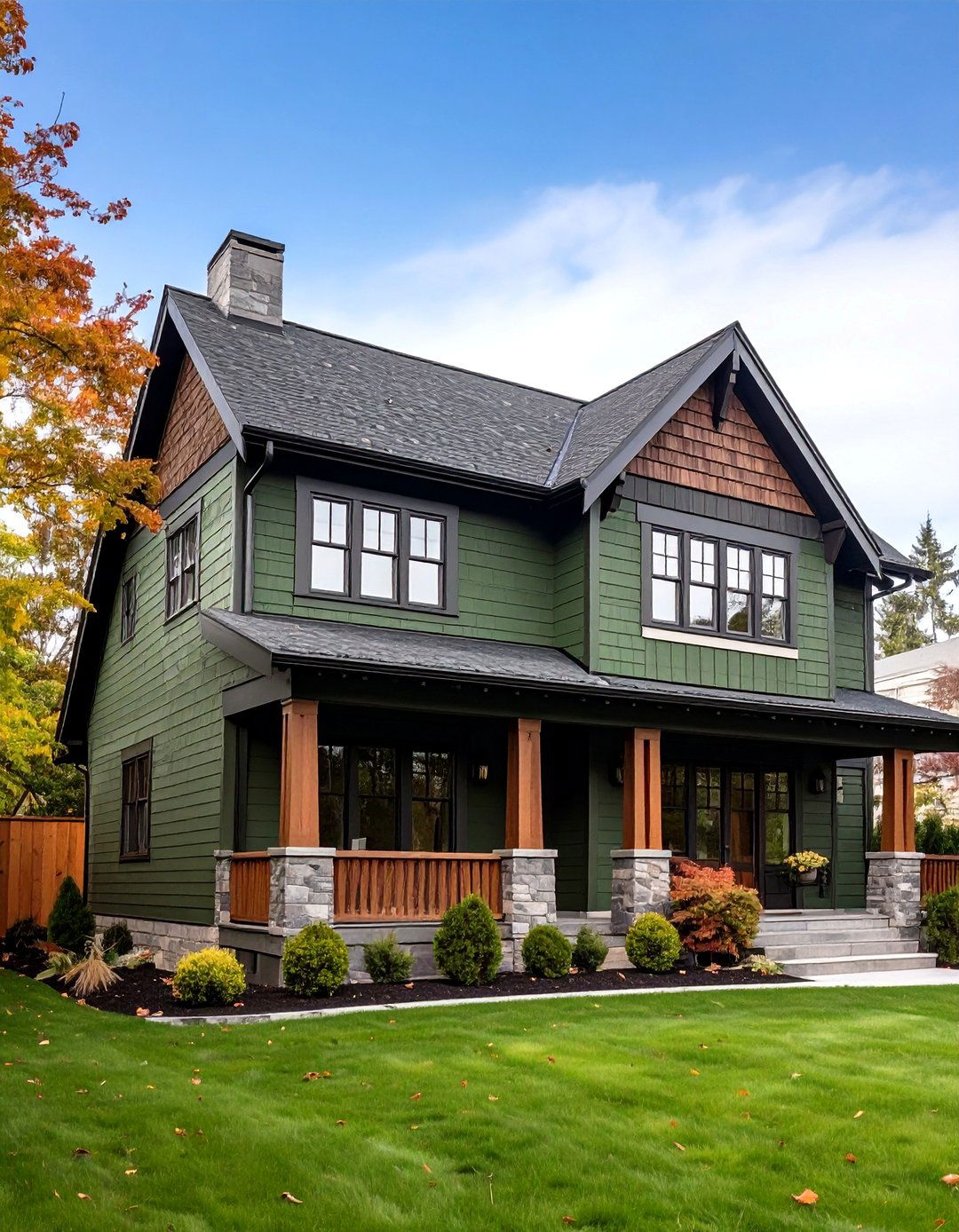
Another texture play involves finishing upper gables with staggered cedar shakes, all stained dark olive green to blend with lap siding below. The irregular edges catch sun differently from flat boards, adding gentle movement to otherwise calm elevations. Maintain black trim only along rake boards and window casings so the eye reads a concise outline amid layered surfaces. Treat cedar with fire-retardant stain where codes demand, ensuring safety doesn’t dilute beauty. The marriage of subtle color with tactile shingle rhythm creates a home that looks handcrafted yet cohesive, recalling coastal cottages while staying squarely in the modern palette.
16. Statement Entry: Black Door on a Dark Olive Green House
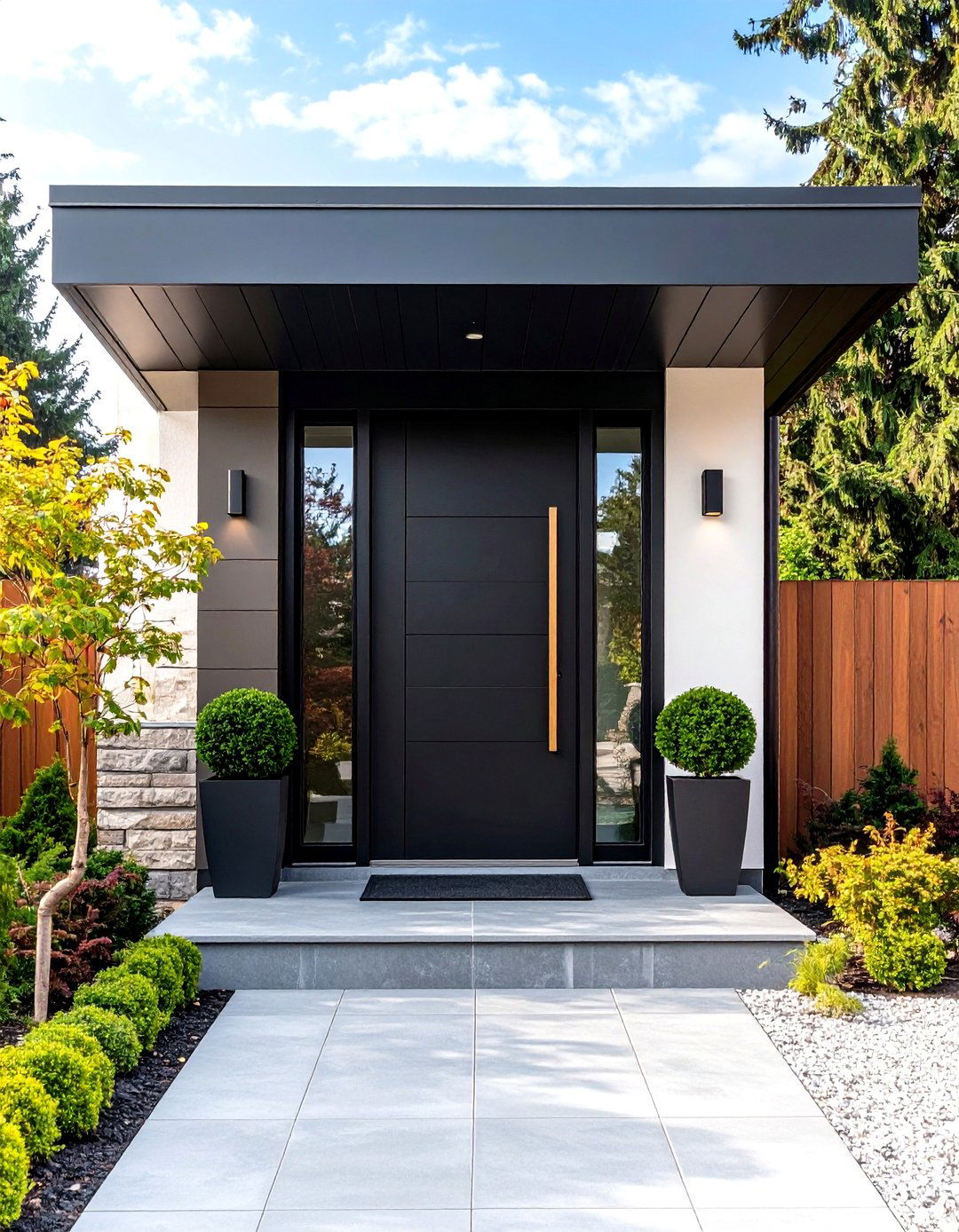
Despite being the smallest surface, a pure-black front door becomes the punctuation mark of a dark olive green house. Choose a high-gloss finish to distinguish it from the satin trim, drawing visitors’ attention and offering an elegant cue for hardware selection. A slim transom or sidelight where code allows provides borrowed light into the foyer without diluting the strong color contrast. To highlight security without clashing, opt for smart locks in matching black or aged bronze. Finally, a custom coir doormat with olive-colored lettering pulls the palette onto the porch, signaling a thoughtful color story from threshold to roof.
17. Evening Glow: Lighting a Dark Olive Green House
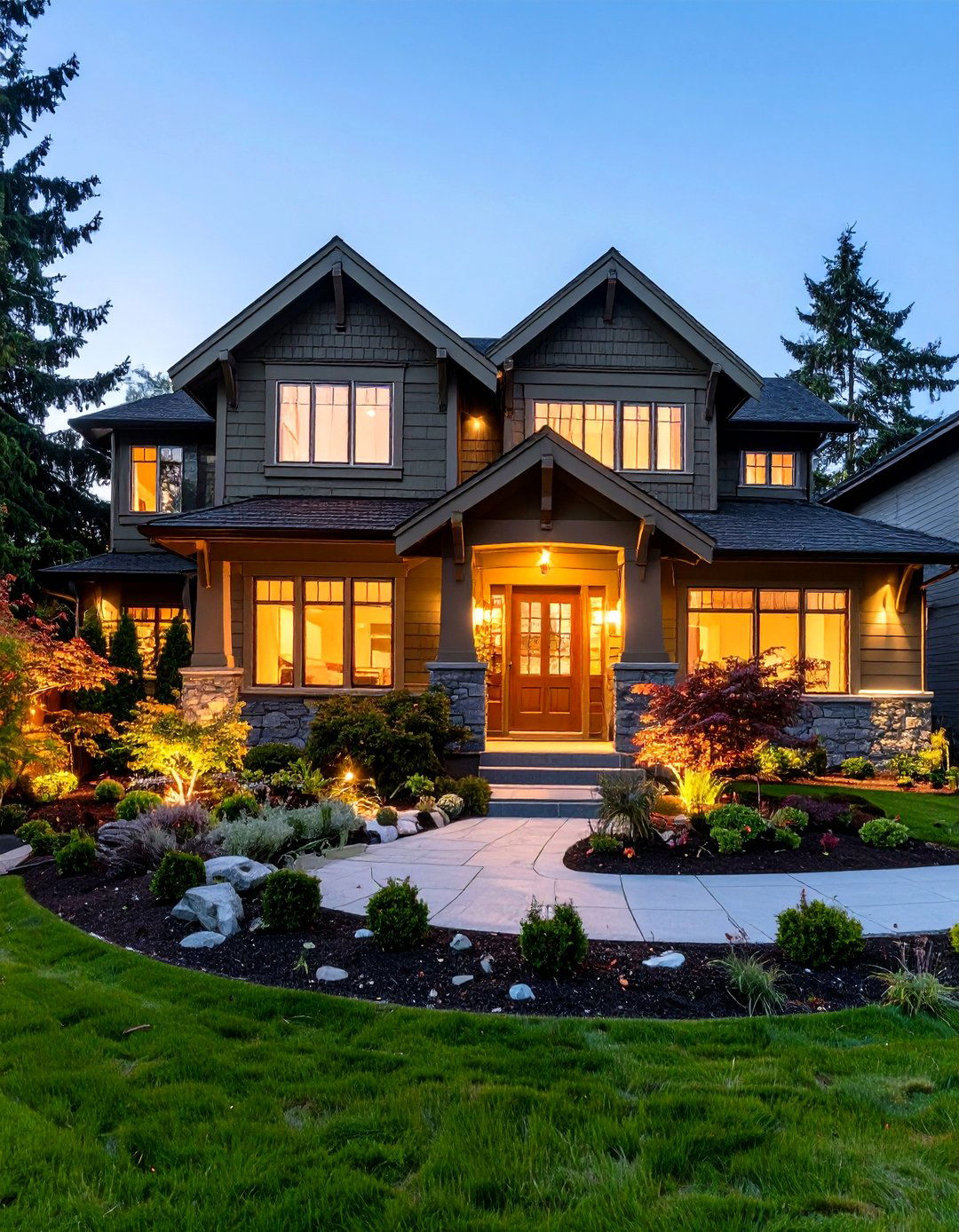
Shortly after dusk, strategic lighting reveals the nuanced undertones of a dark olive green house rather than letting it disappear into the night. Aim sconces downward along trim boards to create graphic beams that echo daylight shadows, and tuck warm-white LED strips under roof overhangs for ambient glow without glare. Spike lights in borders should graze planting shapes, not blast the façade; this subtlety keeps color and texture legible. If energy bills worry you, motion sensors on pathway lights reduce wasted electricity and still deliver safety. An illuminated house looks welcoming year-round and deters intruders more effectively than cameras alone.
18. Illusion of Space for a Compact Dark Olive Green House
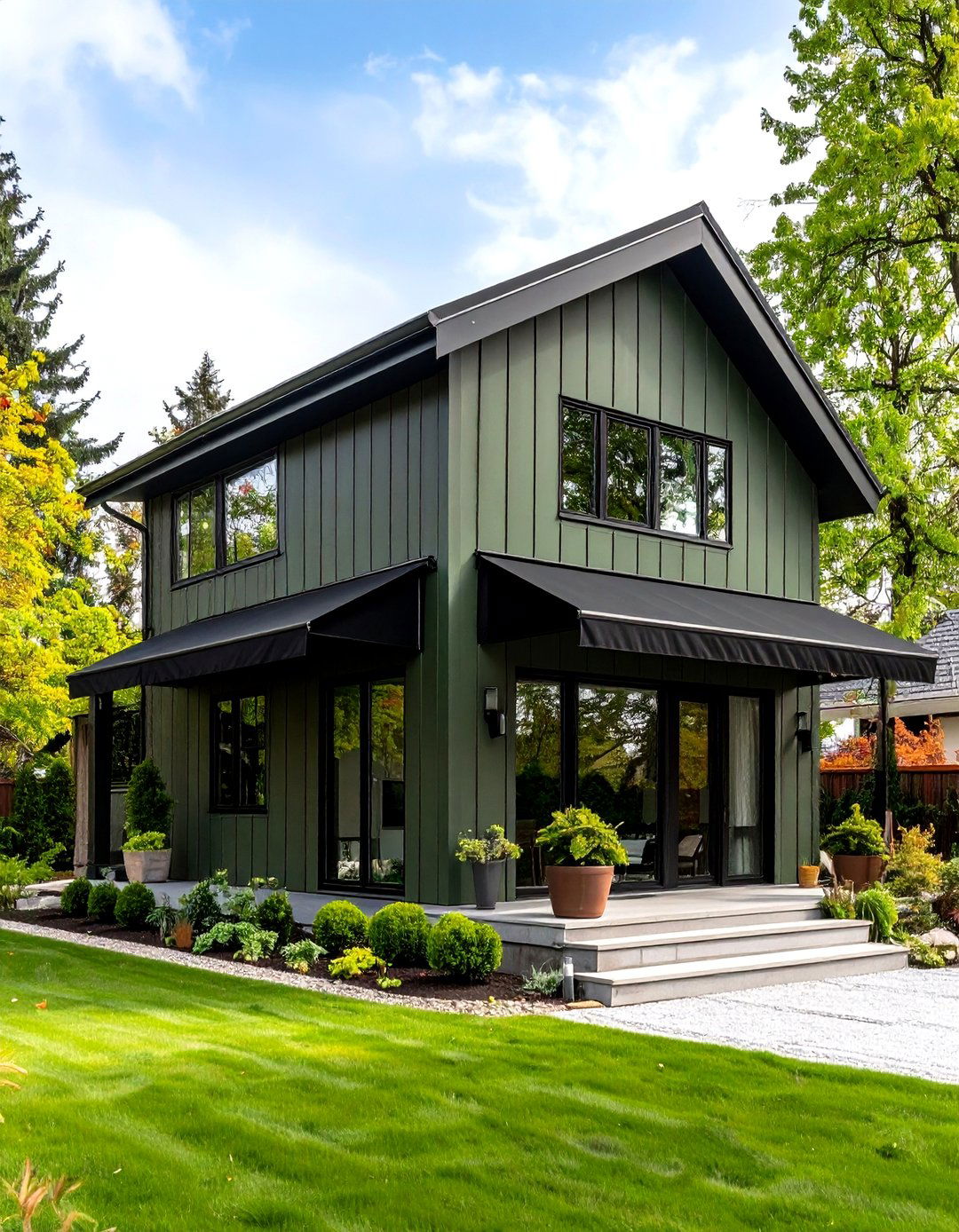
When working with a small lot, an olive green house accented in black can still feel expansive by leveraging verticality. Run siding boards vertically to elongate walls, paint soffits the same dark hue to blur roof intersections, and install tall, narrow windows that direct the gaze upward. A black standing-seam awning installed just above eye level visually lifts the façade further. Inside, continue the exterior palette on window reveals to strengthen the sense of volume. The controlled color scheme minimizes visual noise, allowing modest square footage to project confidence and presence, proving bold tones are not exclusive to large properties.
19. Smart-Tech Integration for a Dark Olive Green House
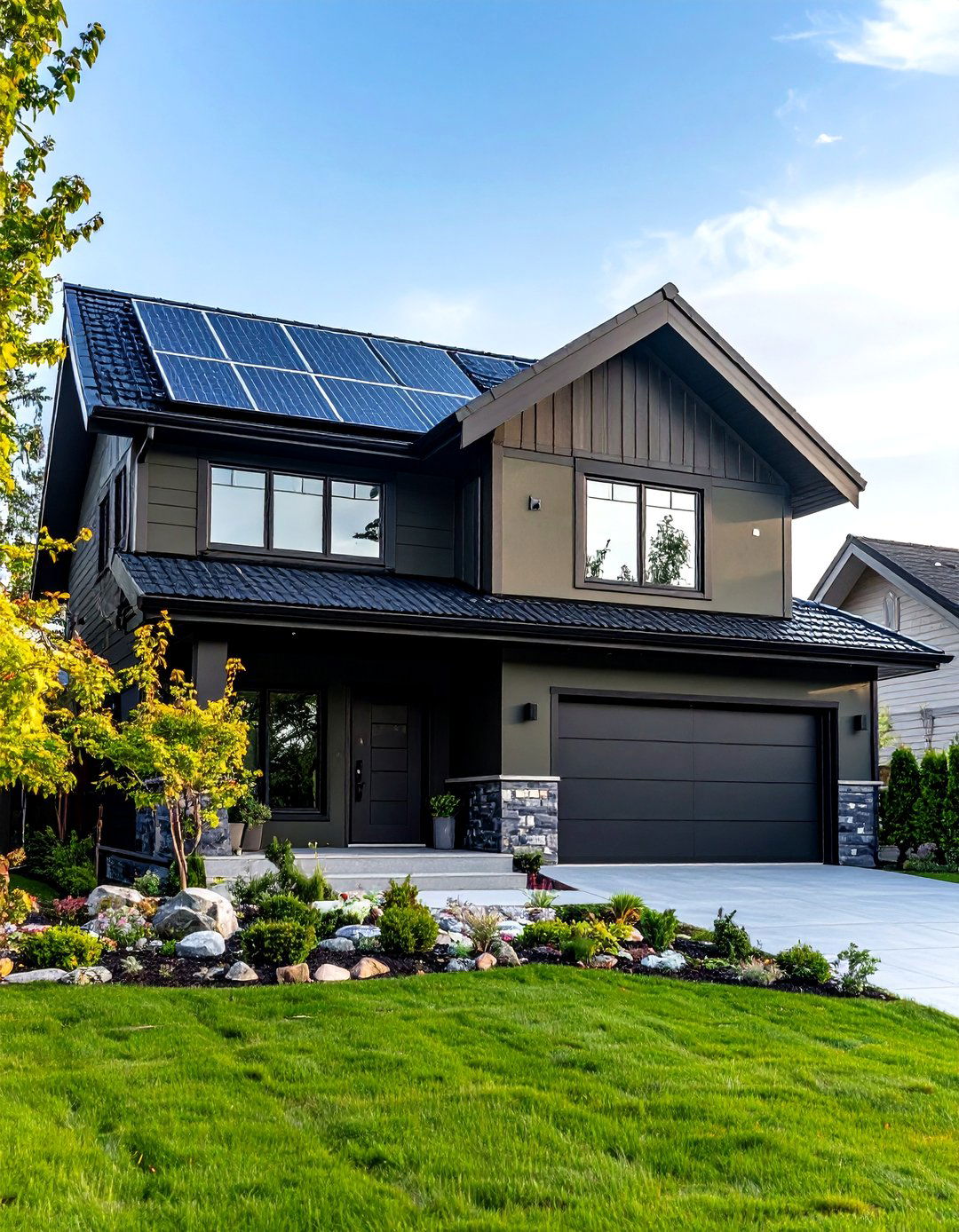
Technology can disappear gracefully on a dark olive green house when smart cameras, doorbells, and solar panels adopt matching colorways. Many manufacturers now powder-coat casings in custom blacks or deep greens, preventing visual clutter against the façade. Position solar panels on a black metal roof where their dark cells blend almost seamlessly, preserving architectural integrity. To reduce wiring runs, consider PoE lighting fixtures routed through attic spaces; the hidden infrastructure keeps eaves clean. The seamless marriage of smart tech and sophisticated palette demonstrates that modern convenience needn’t sacrifice curb appeal, creating a home that feels forward-thinking in both form and function.
20. Seasonal Styling Tips for a Dark Olive Green House Exterior
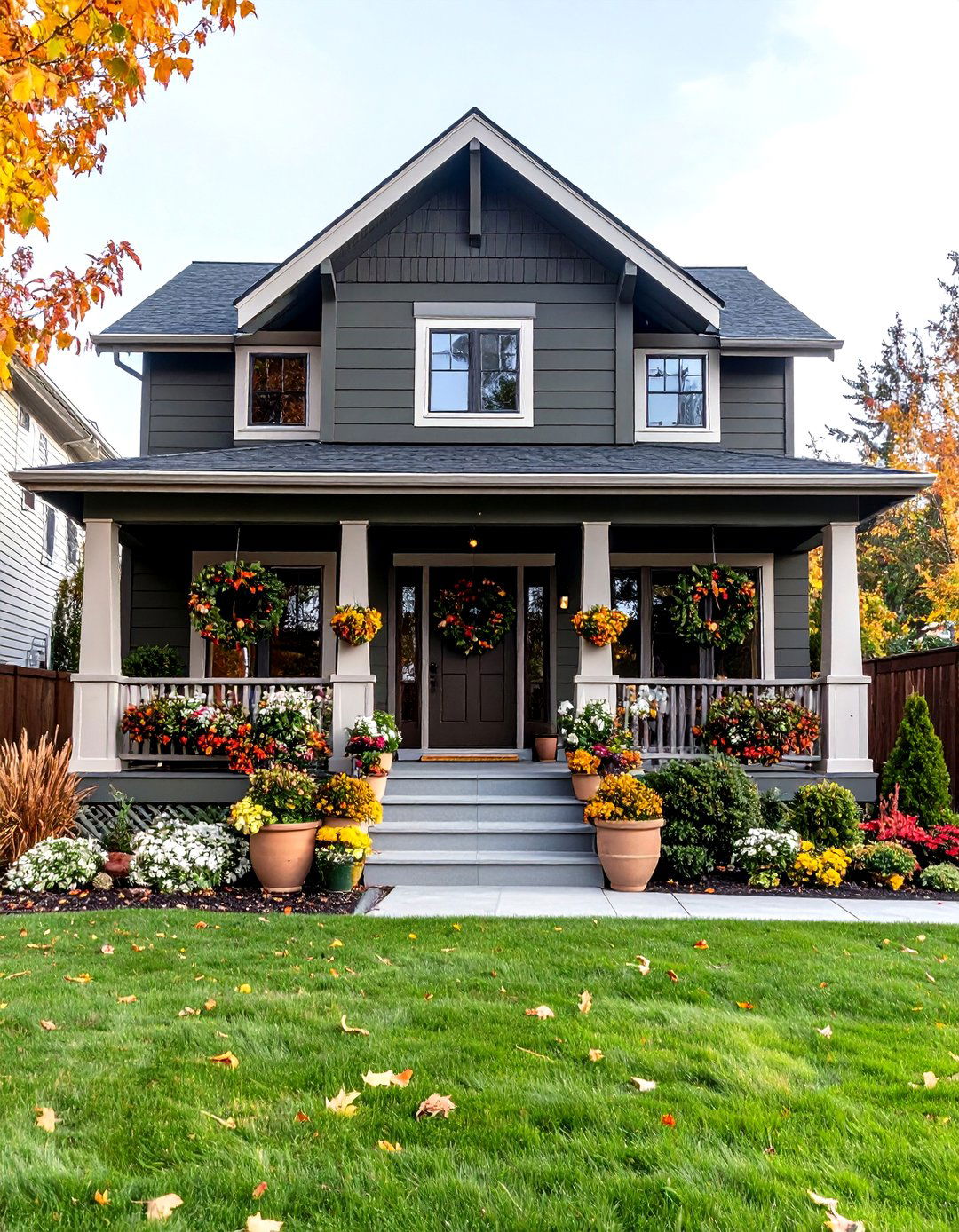
Finally, celebrating seasons on a dark olive green house requires only restrained accents so the primary palette remains center stage. In spring, pale terracotta planters echo warm undertones; in summer, pewter lanterns mirror black trim without heat-absorbing metal buying glare. Autumn demands nothing more than natural straw wreaths that complement olive foliage, while winter’s snowy backdrop magnifies the green’s richness—no extra décor needed. Swap doormats and porch textiles rather than repaint or replant; the consistent color foundation means small changes read large. This mindful approach keeps maintenance low and visual clutter absent, letting the home breathe year-round with quiet confidence.
Conclusion:
Dark olive green wrapped in confident black trim proves adaptable, sustainable, and undeniably stylish across architectural eras and climates. Whether you lean into minimalist glazing, rustic stone, or smart-tech subtlety, the palette’s inherent balance between earthiness and edge invites endless personal expression while commanding strong resale value. By focusing on thoughtful textures, eco-aware materials, and strategic lighting, each of the twenty ideas above demonstrates how a simple color duet can uplift comfort, curb appeal, and design credibility at once. Embrace the shade, respect the trim, and watch your exterior tell a story that never goes out of season.


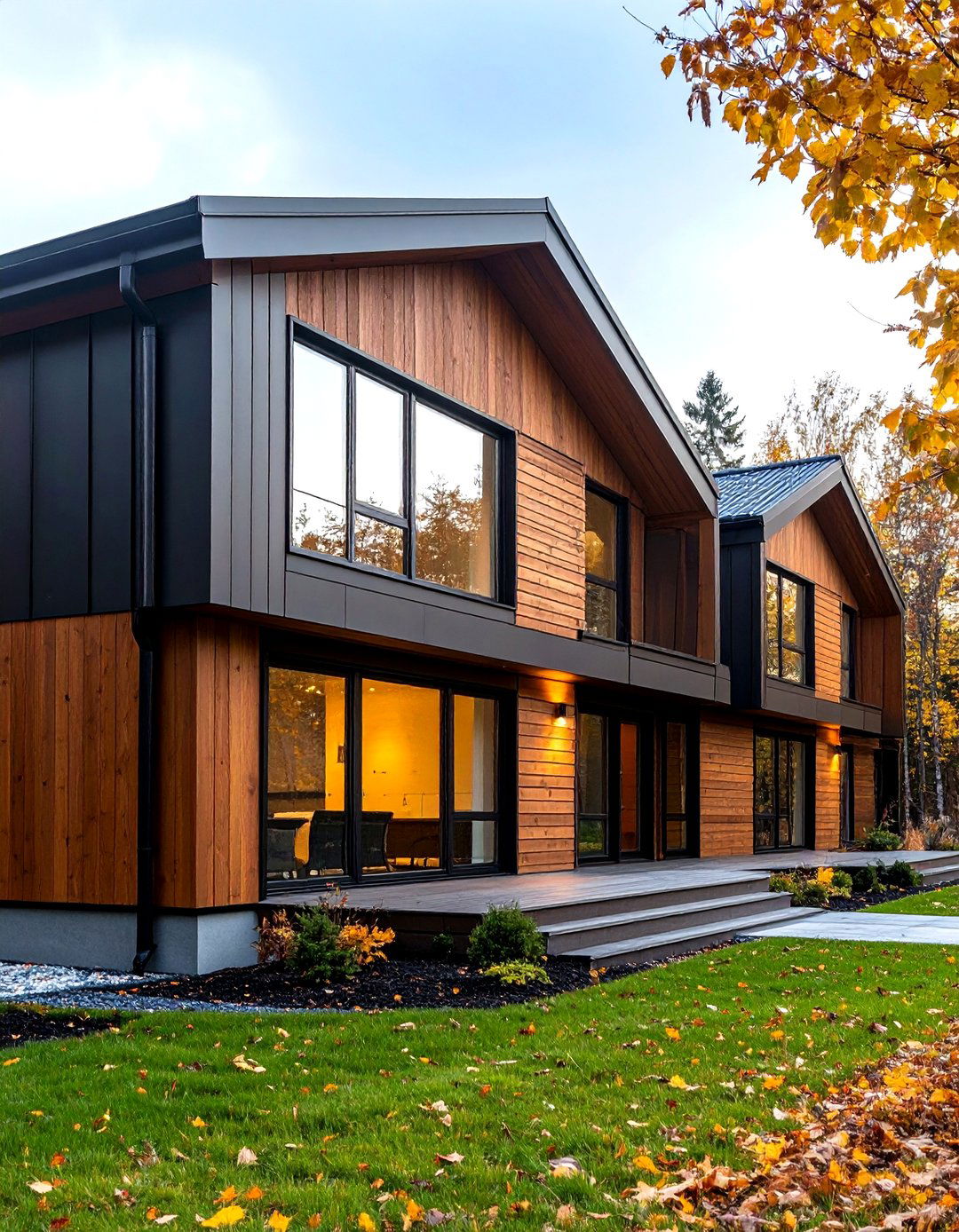
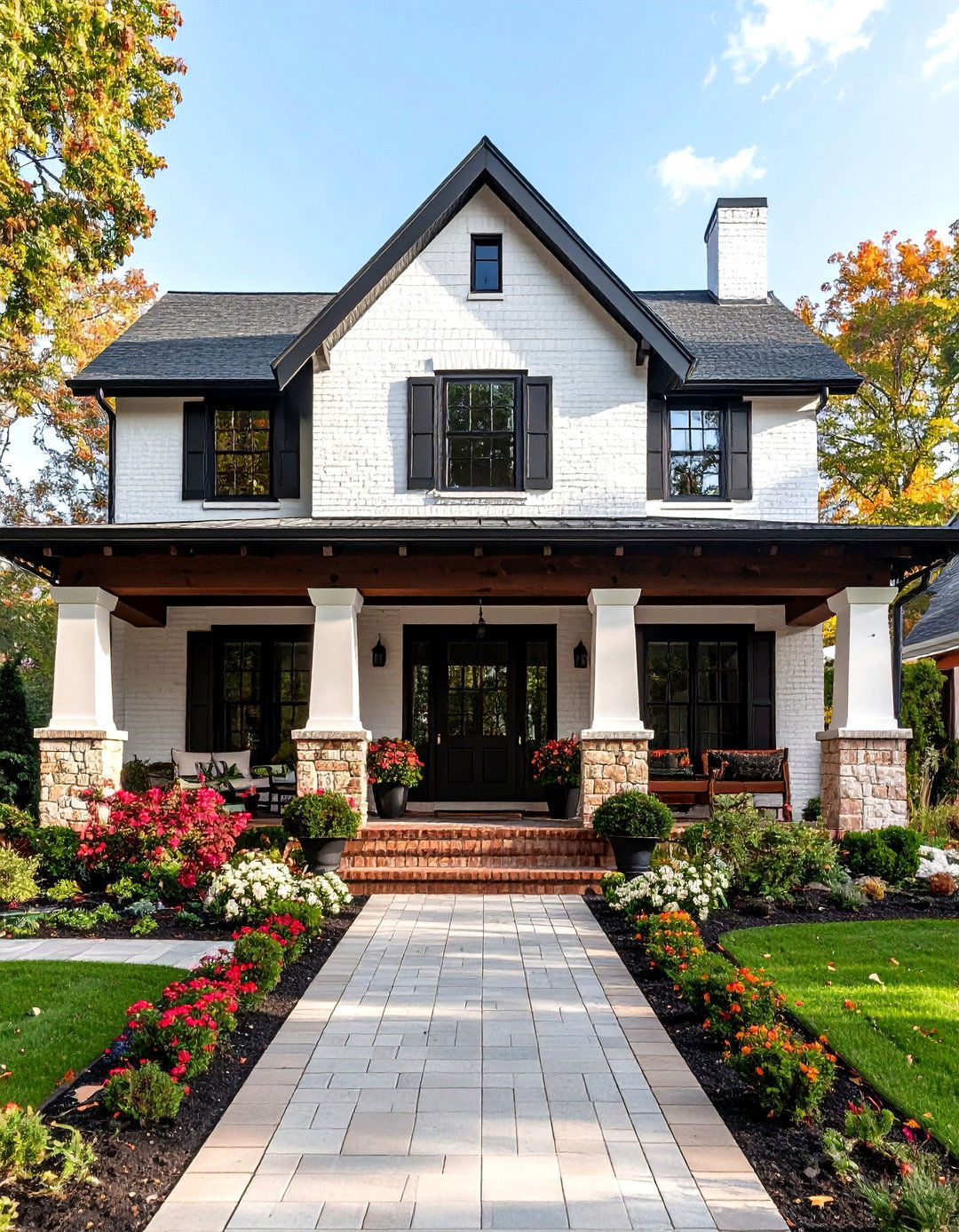
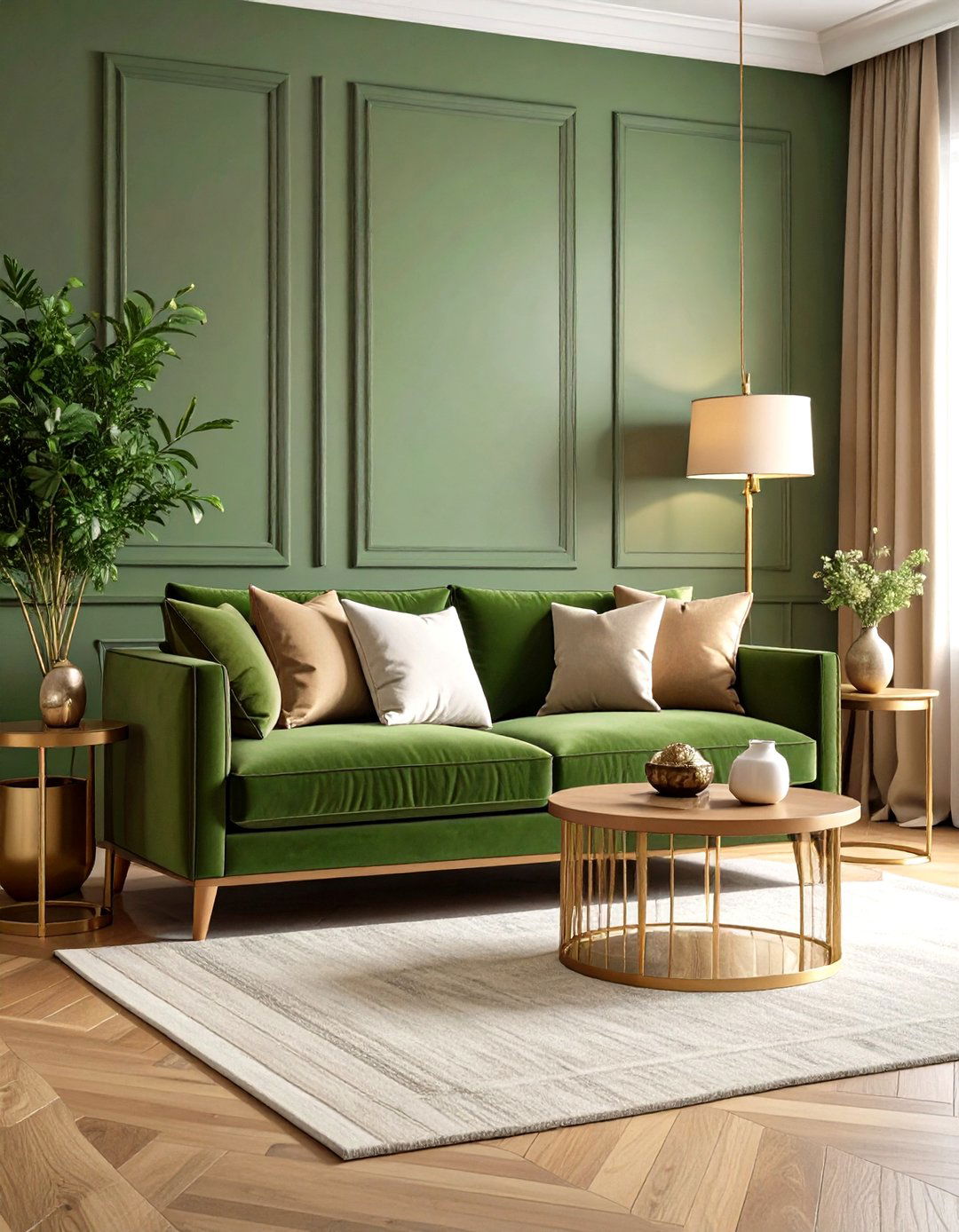
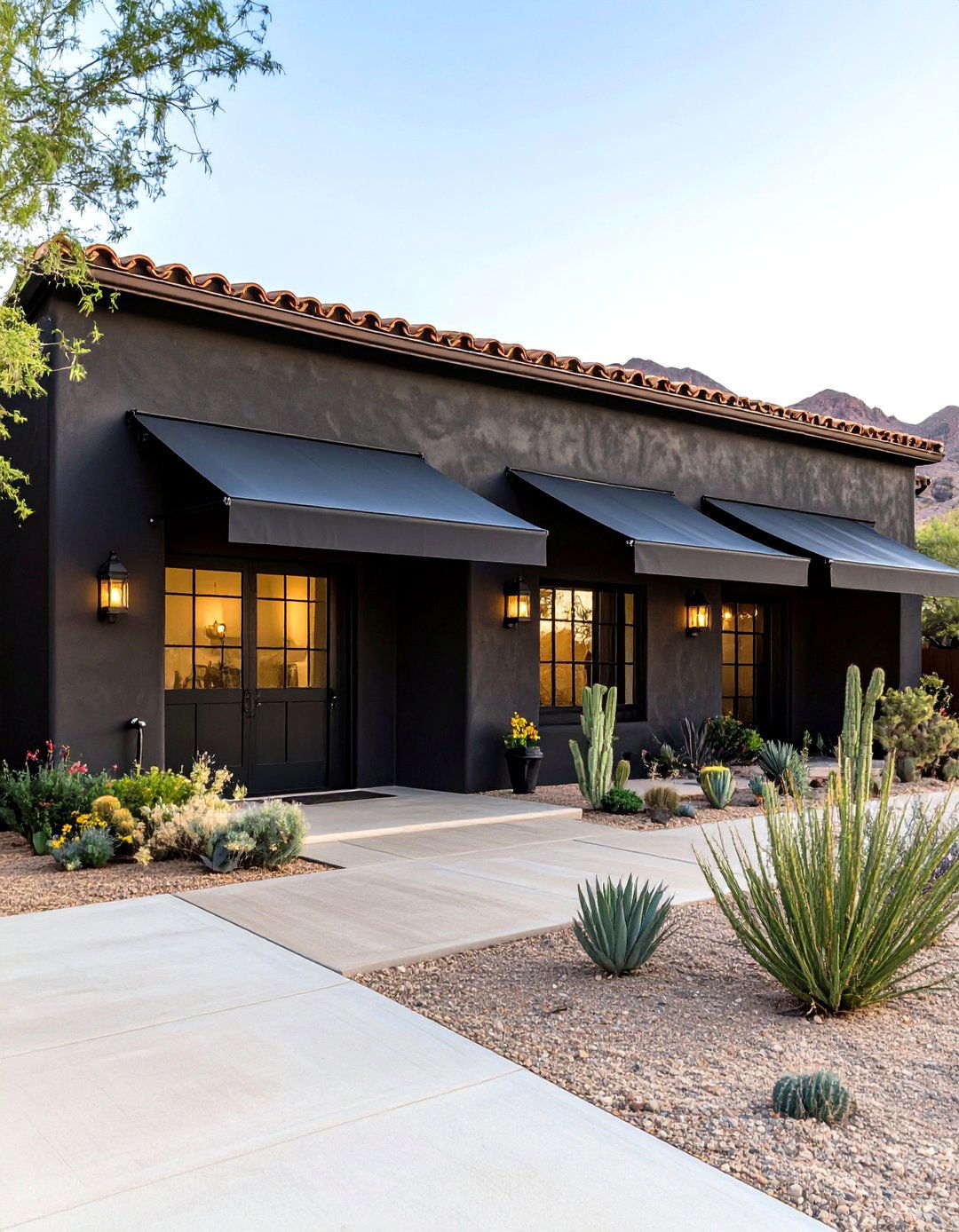
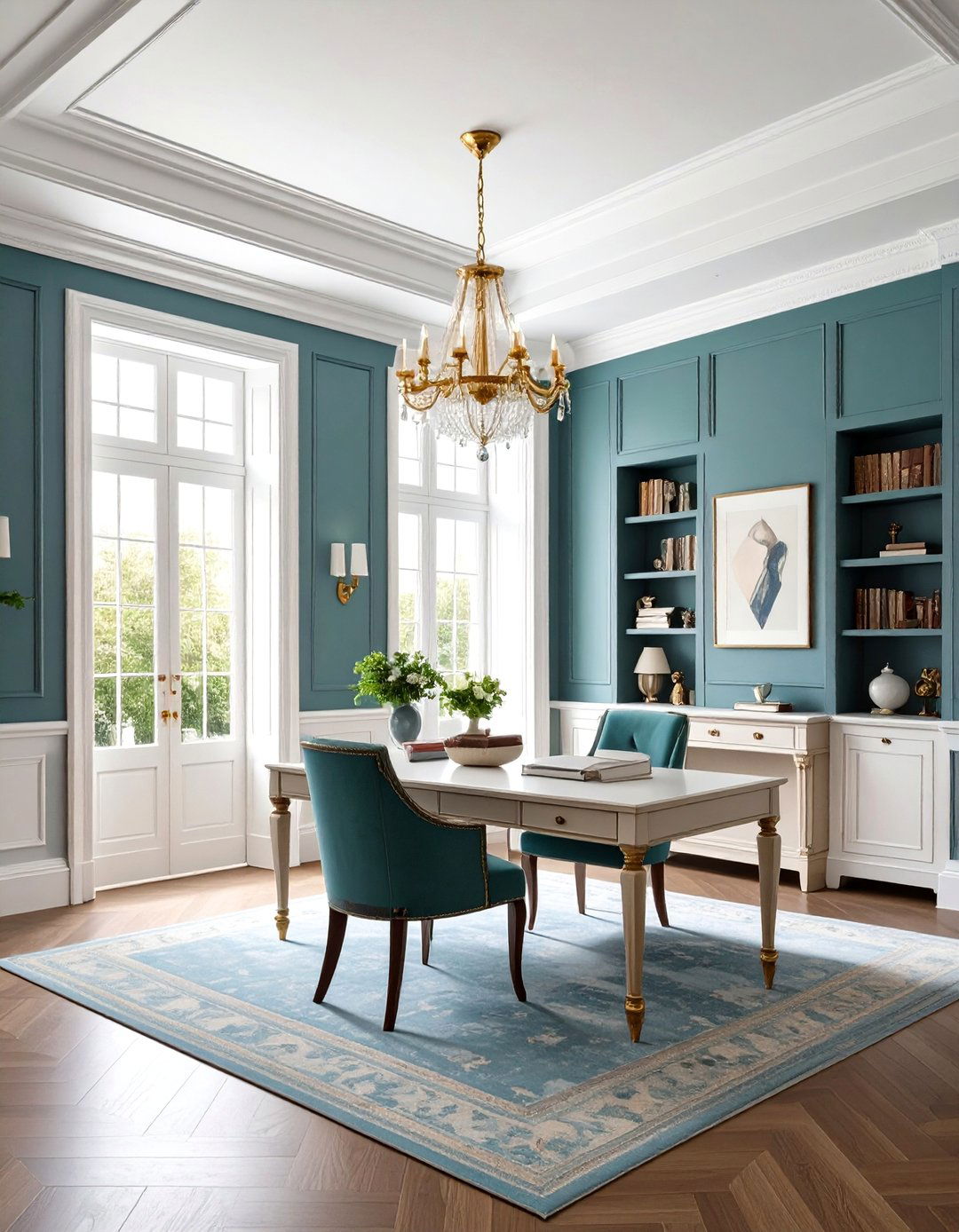
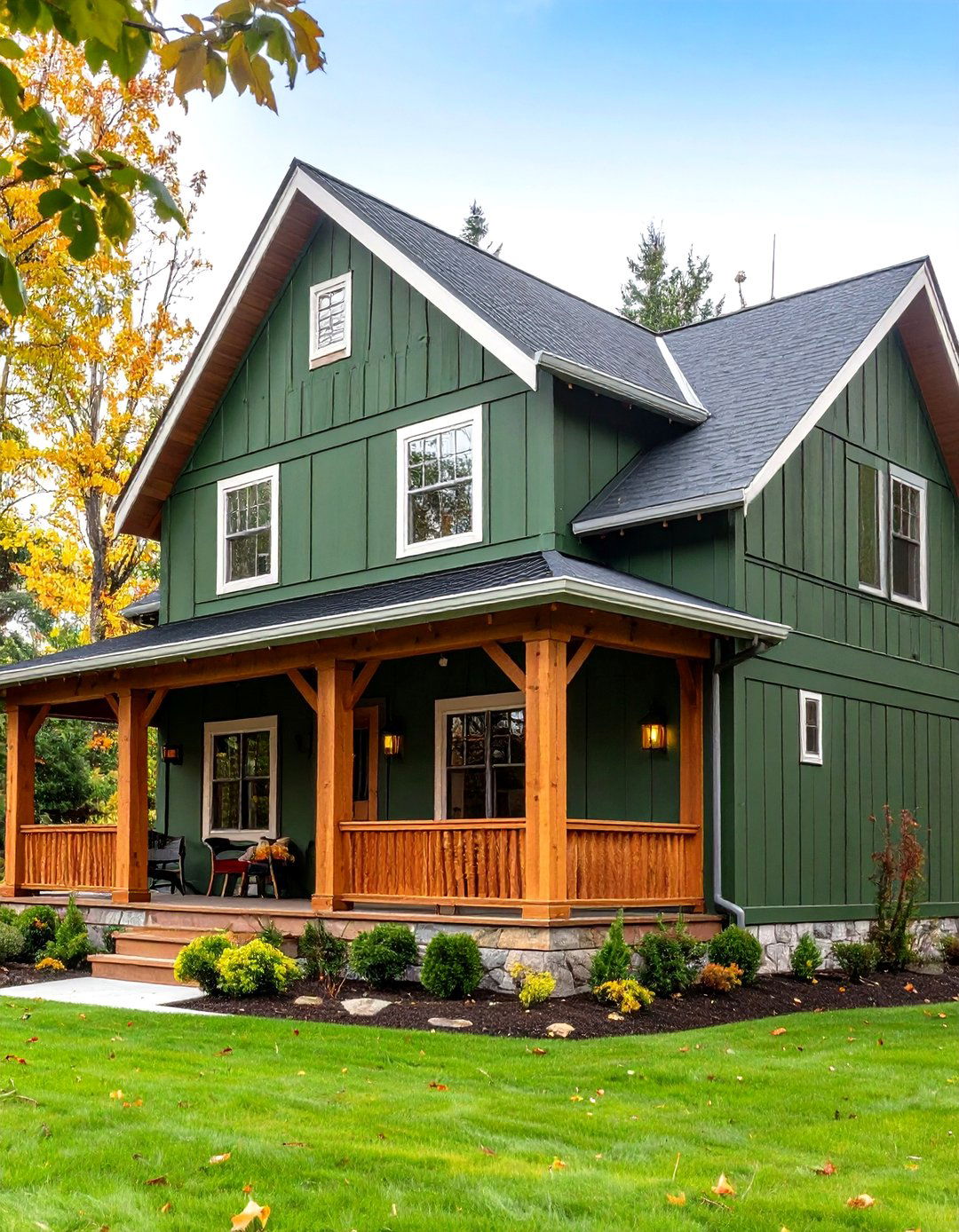
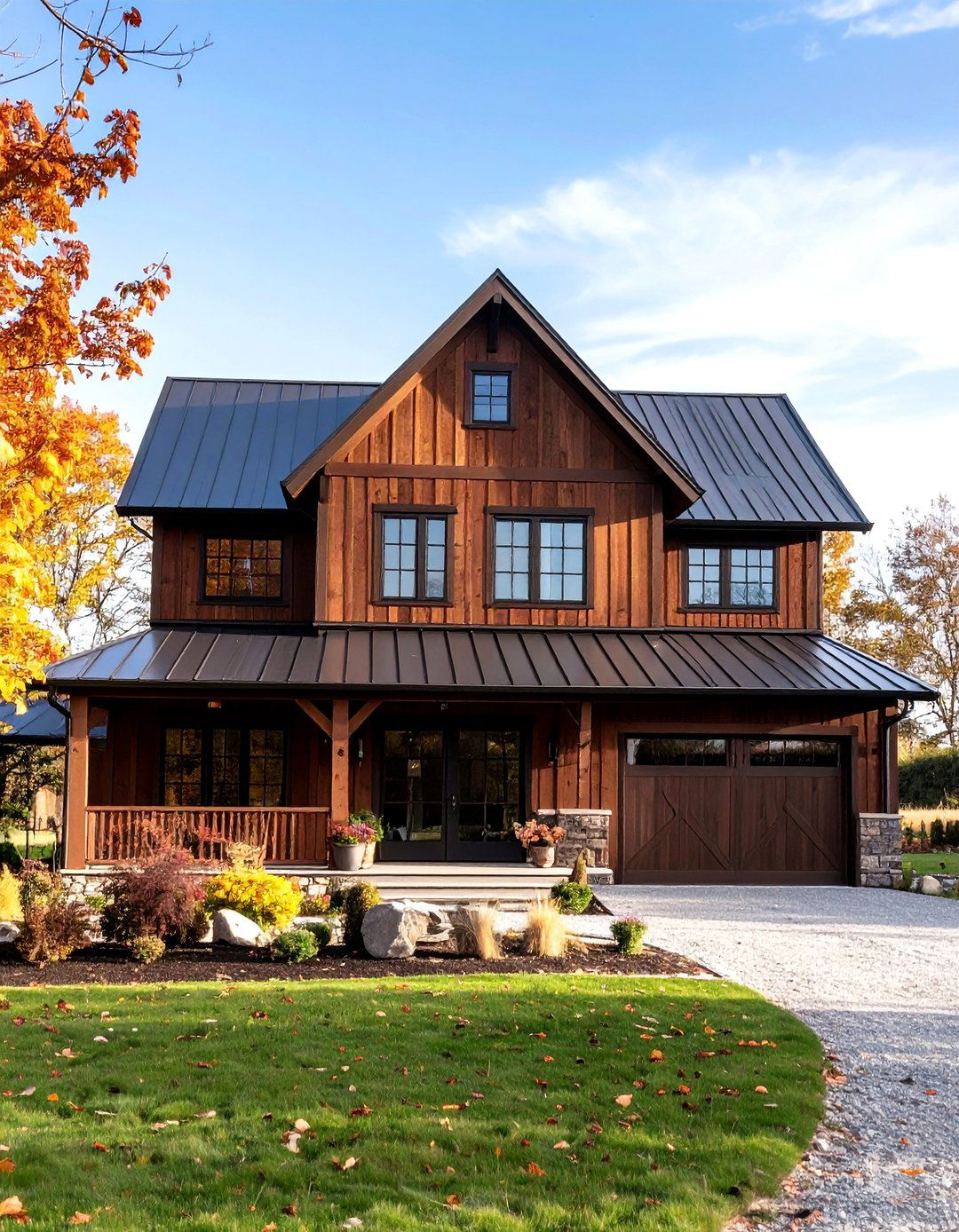
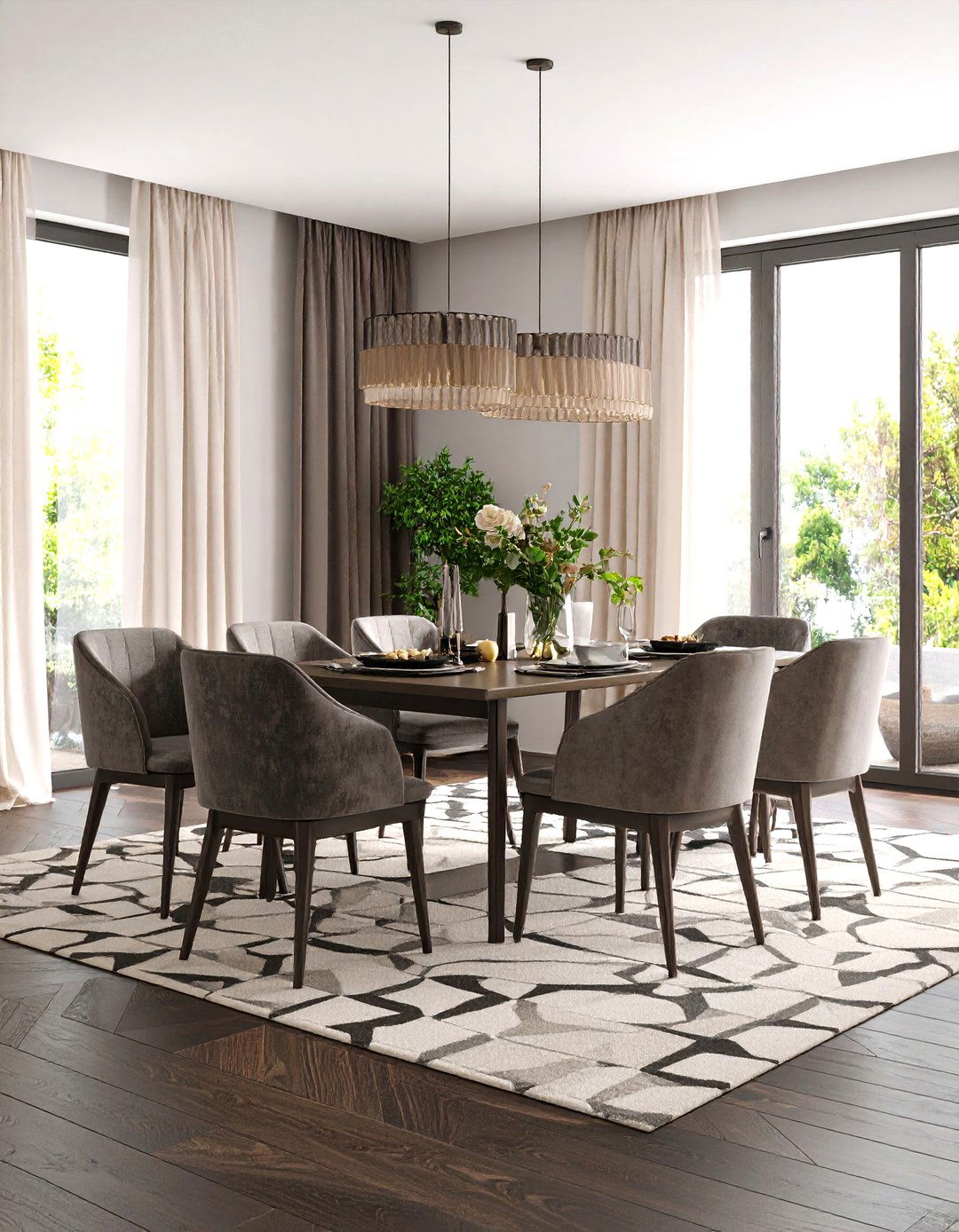
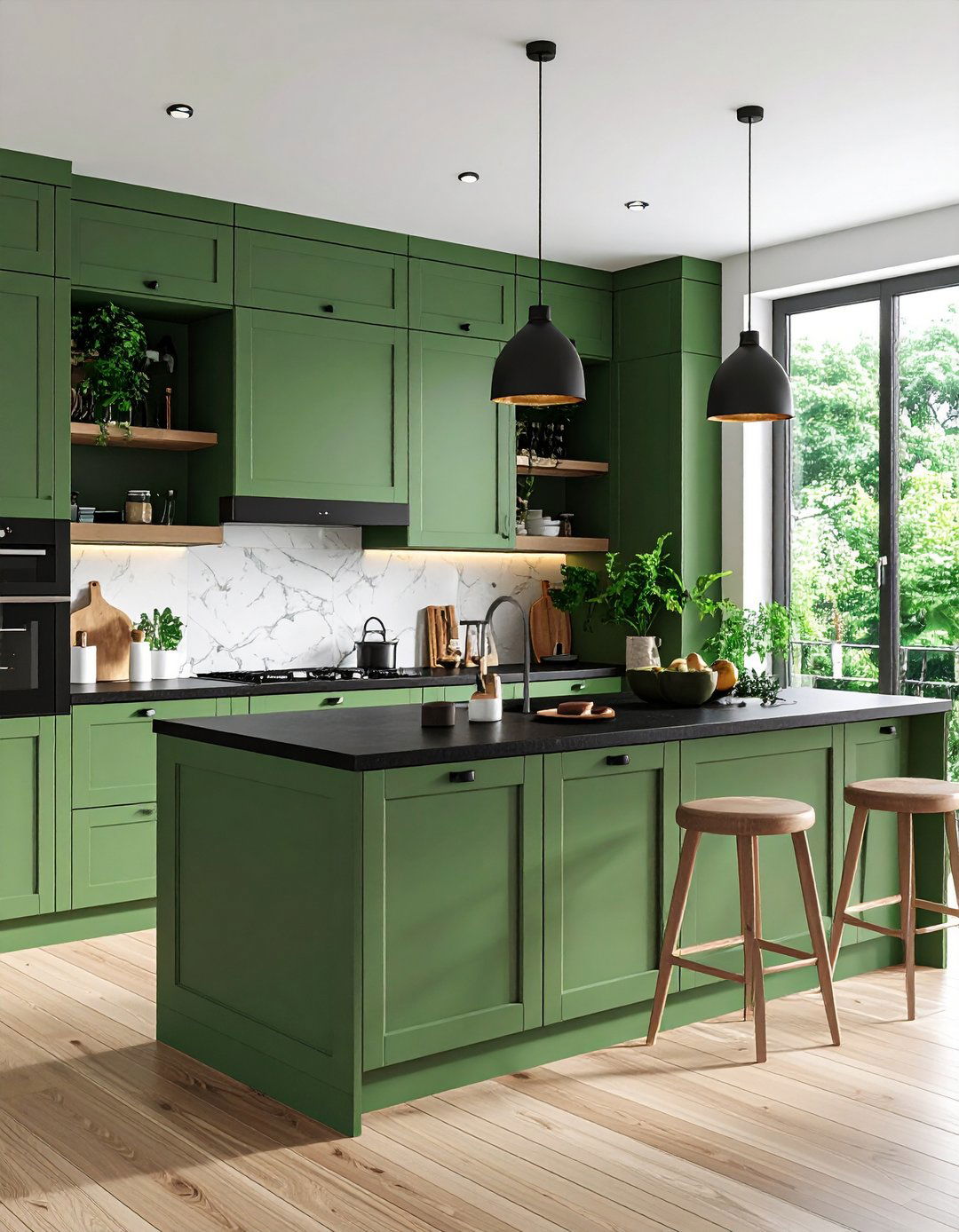

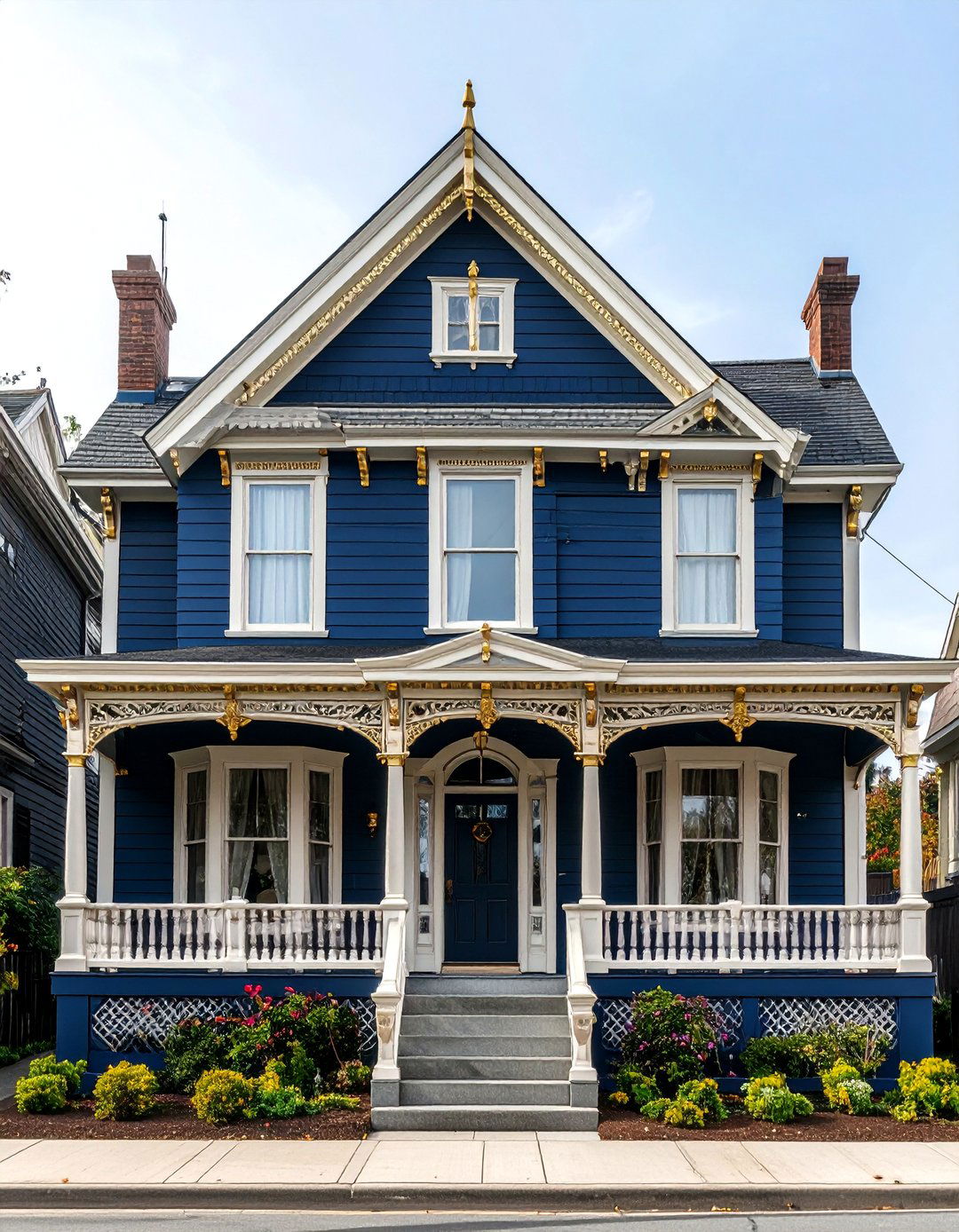
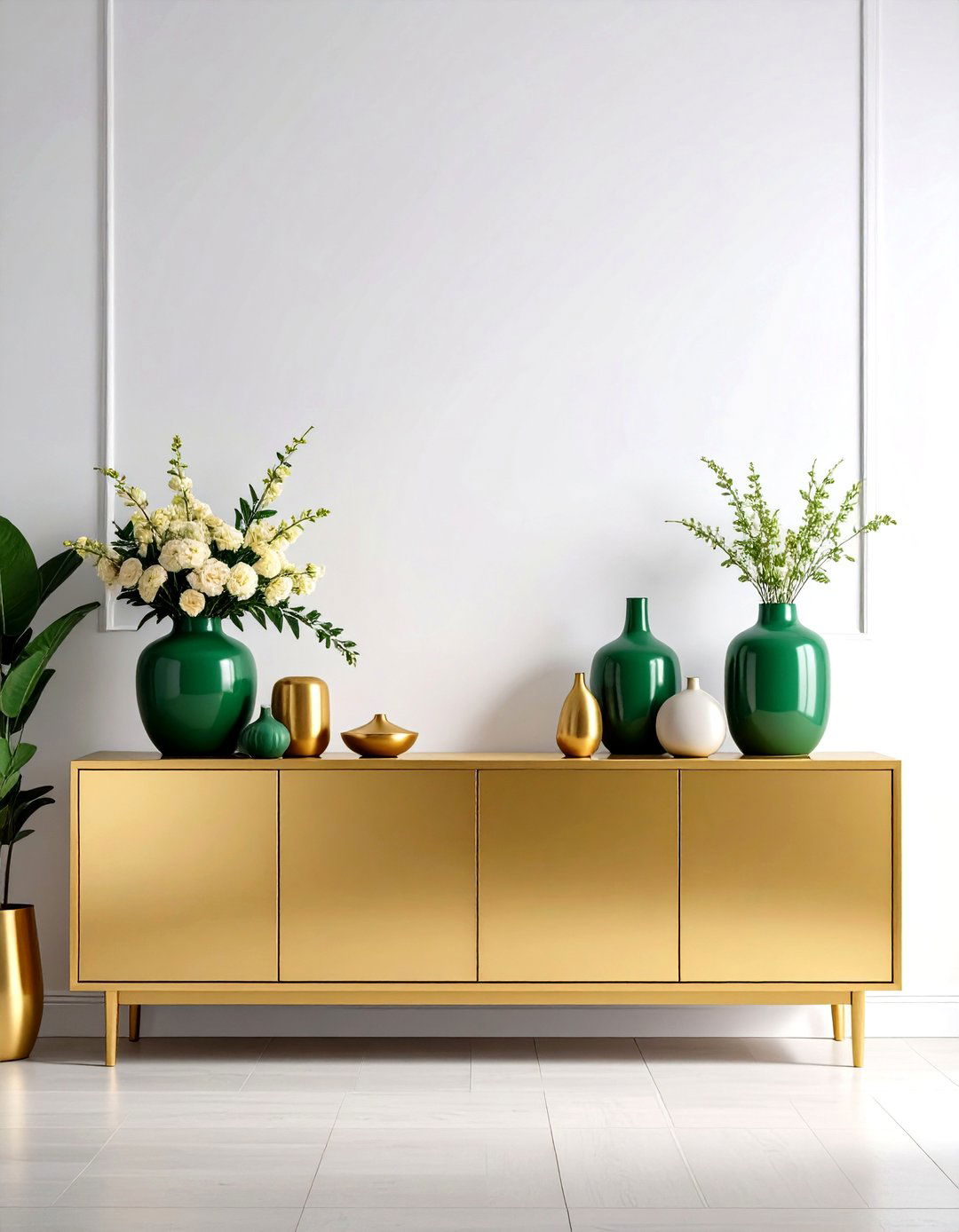
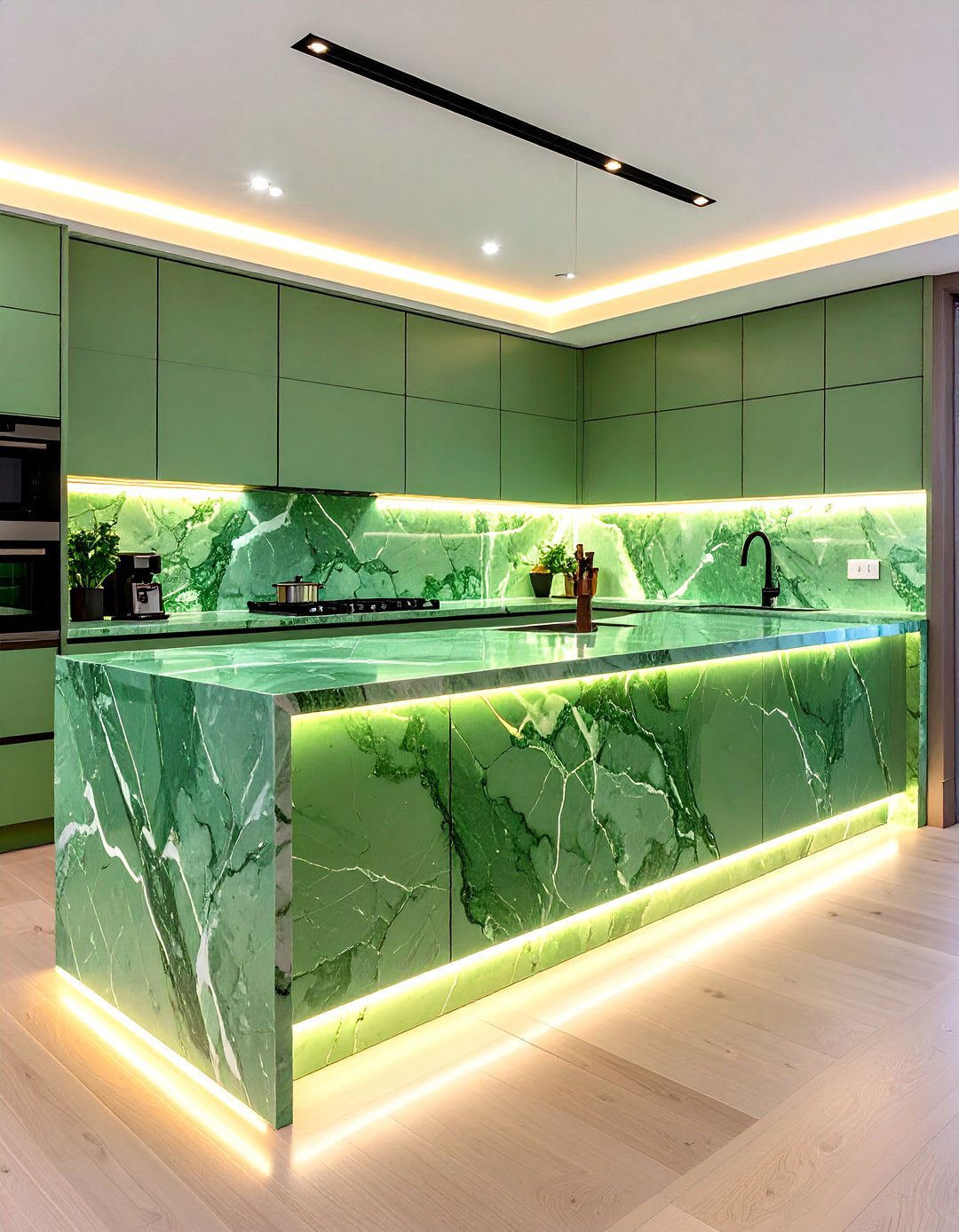
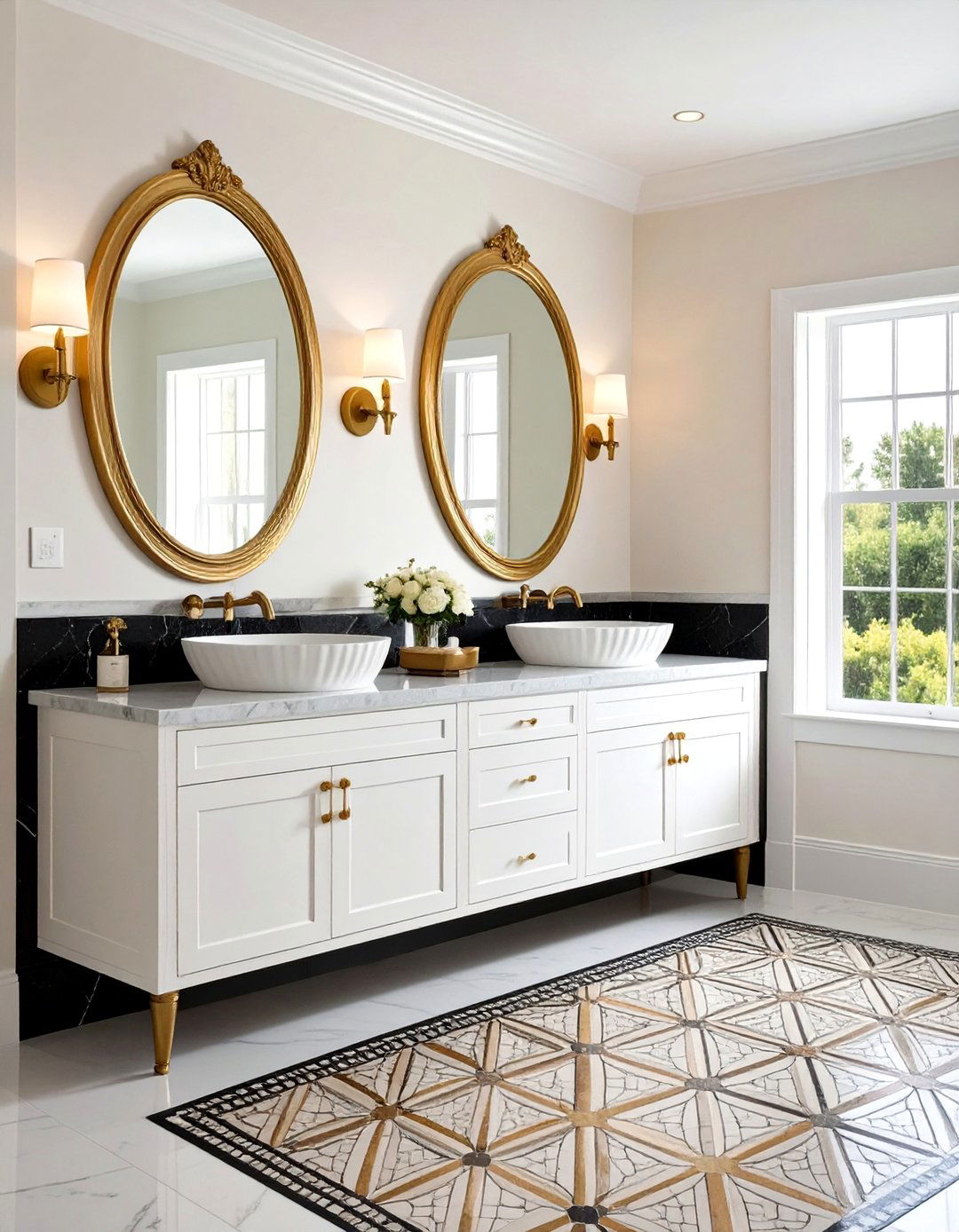
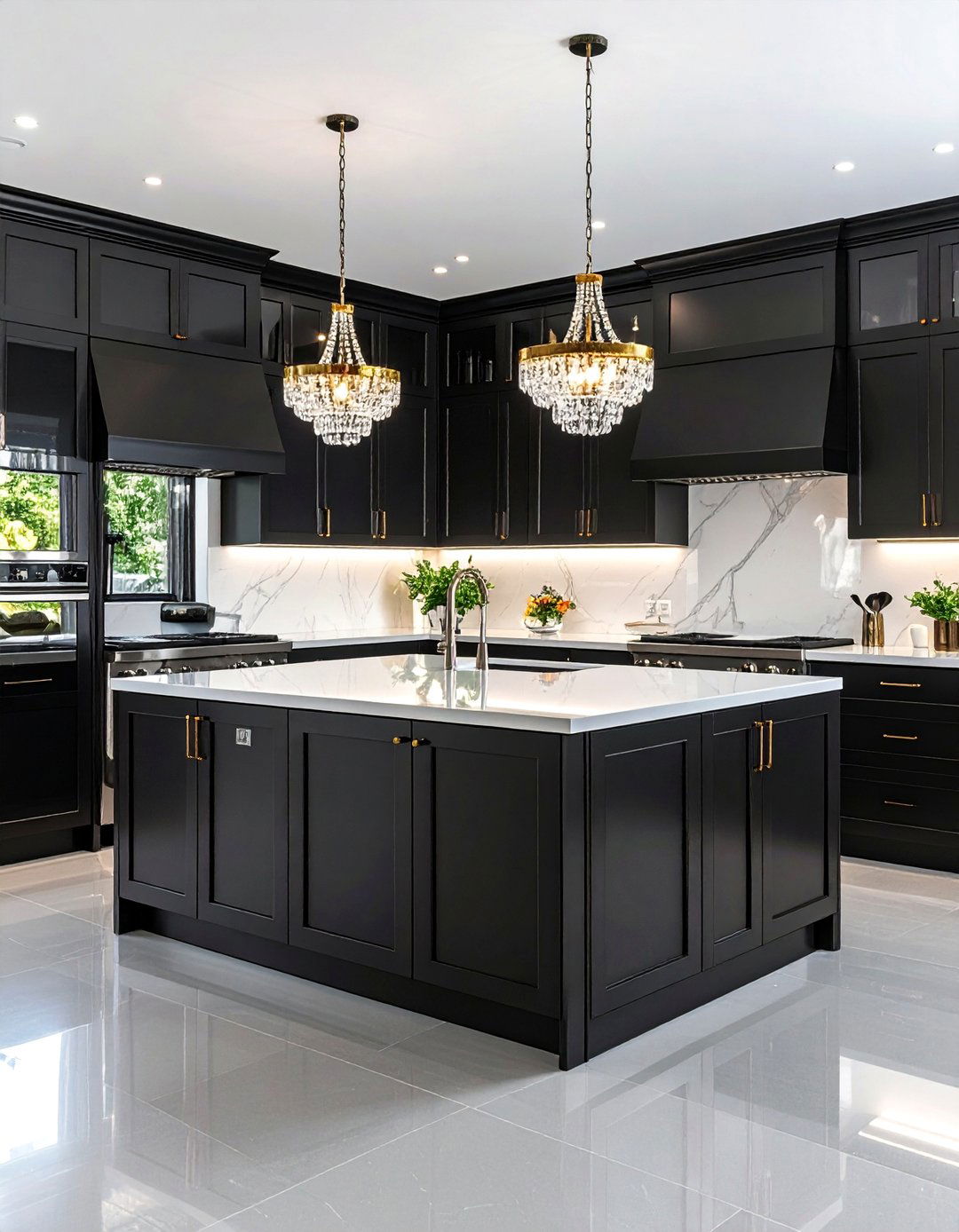
Leave a Reply